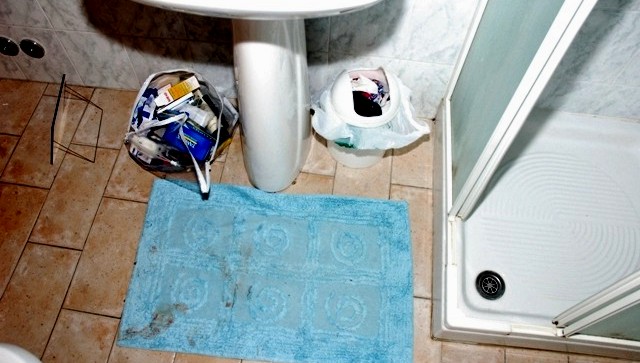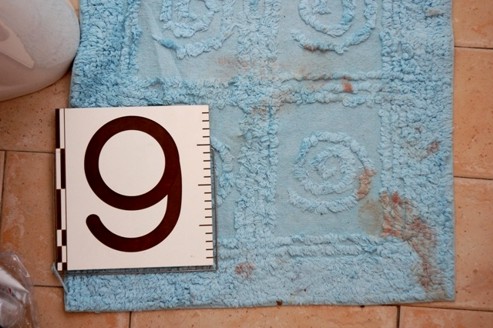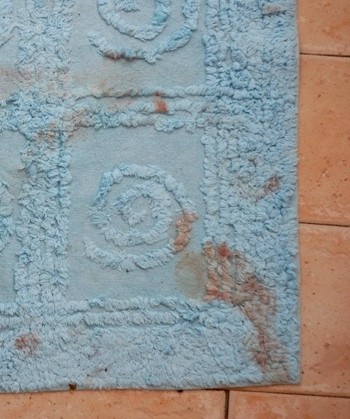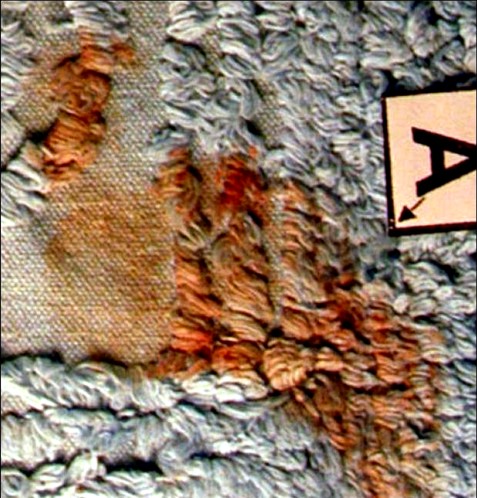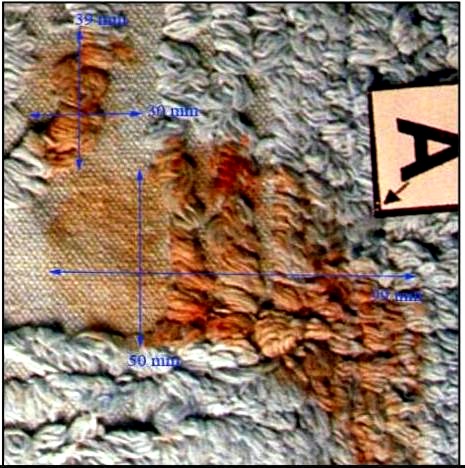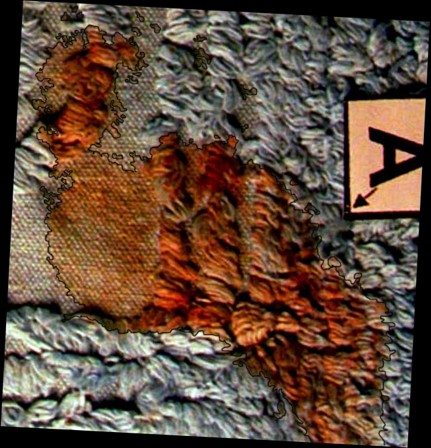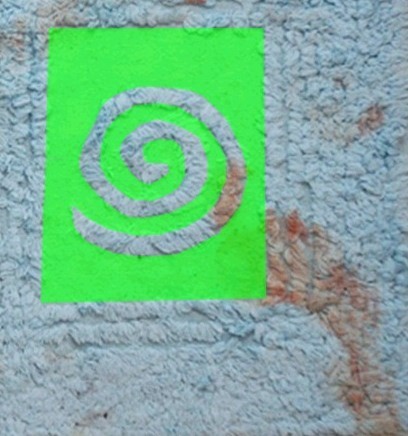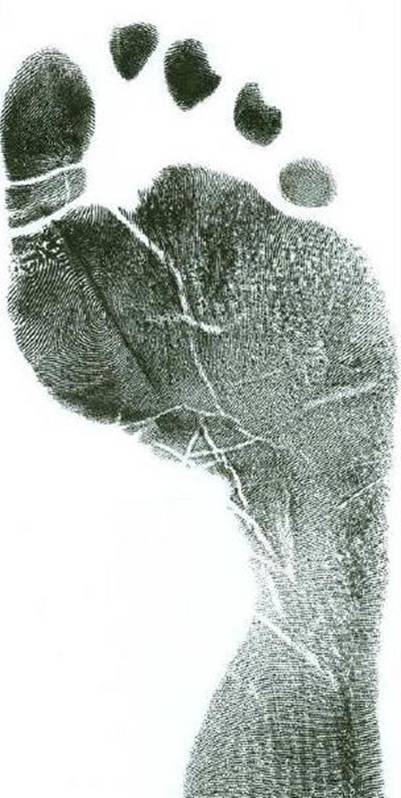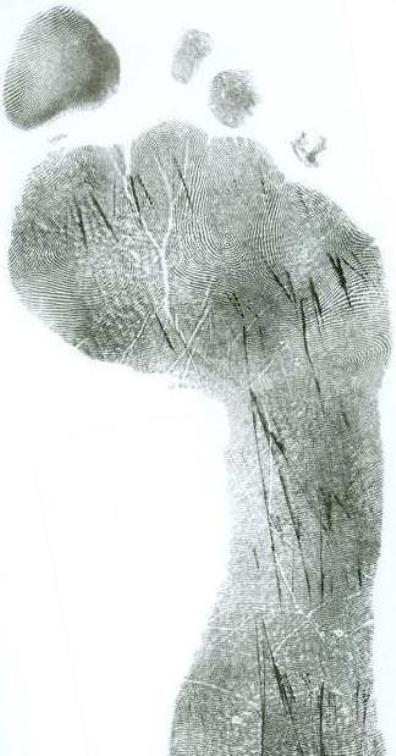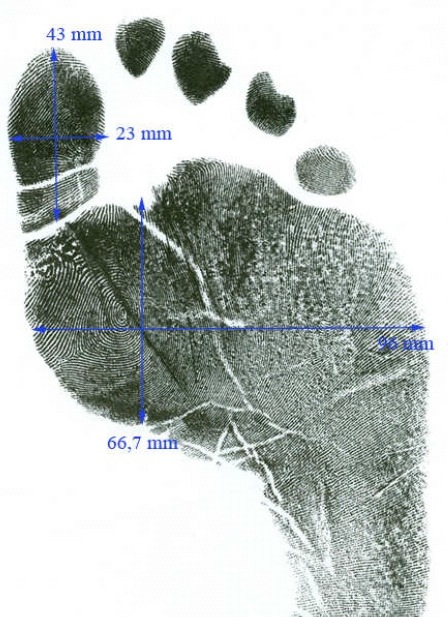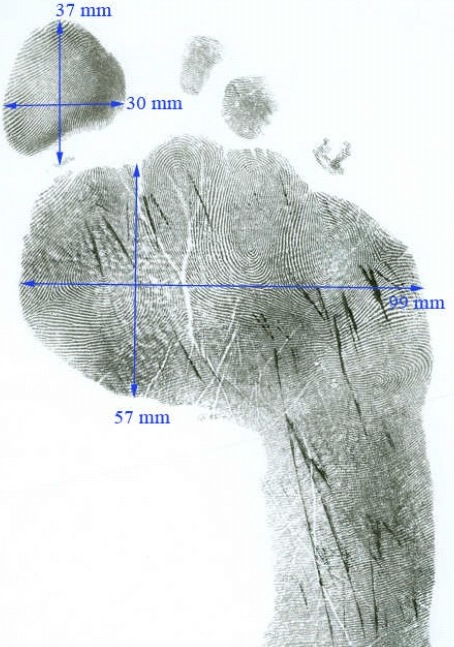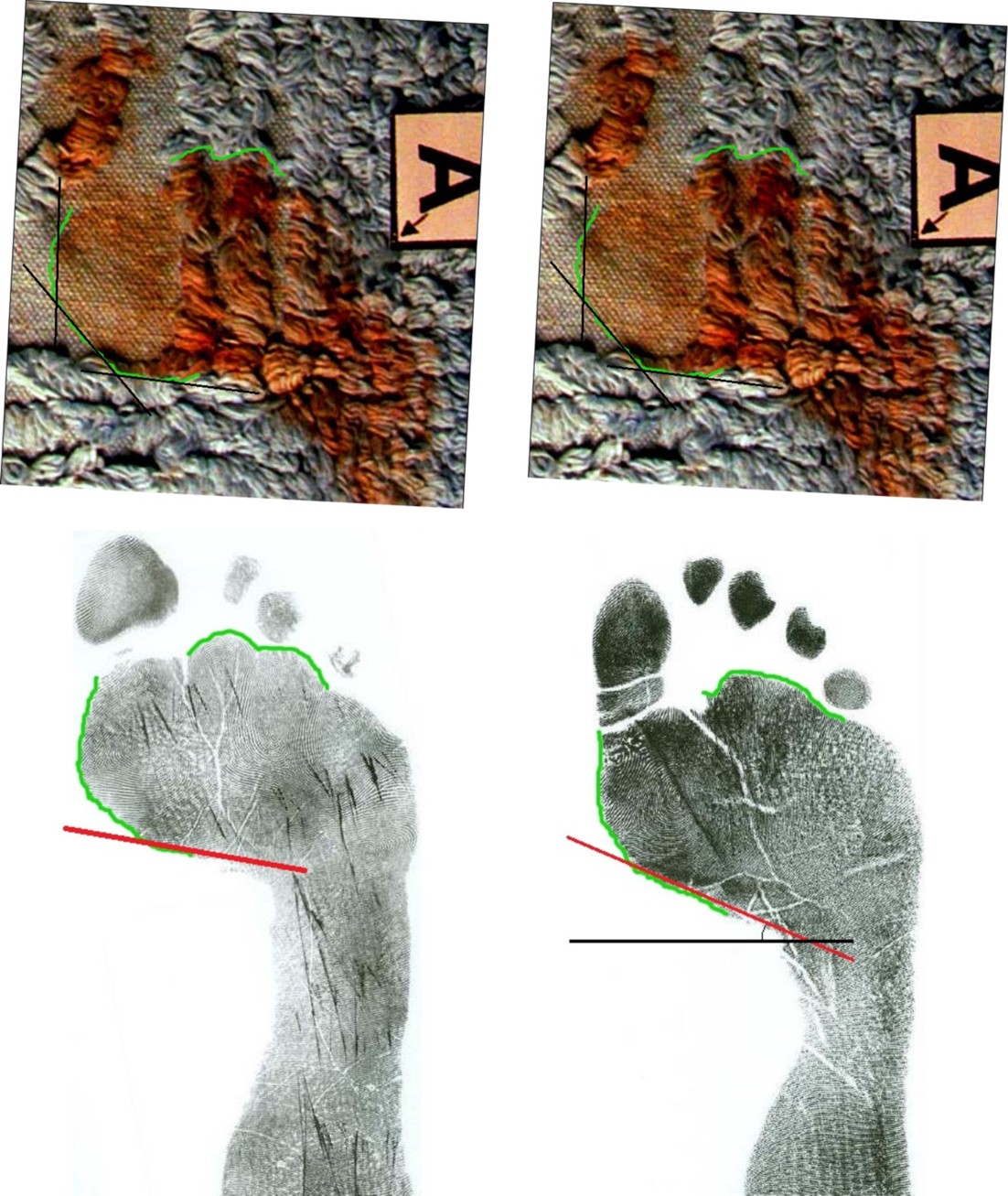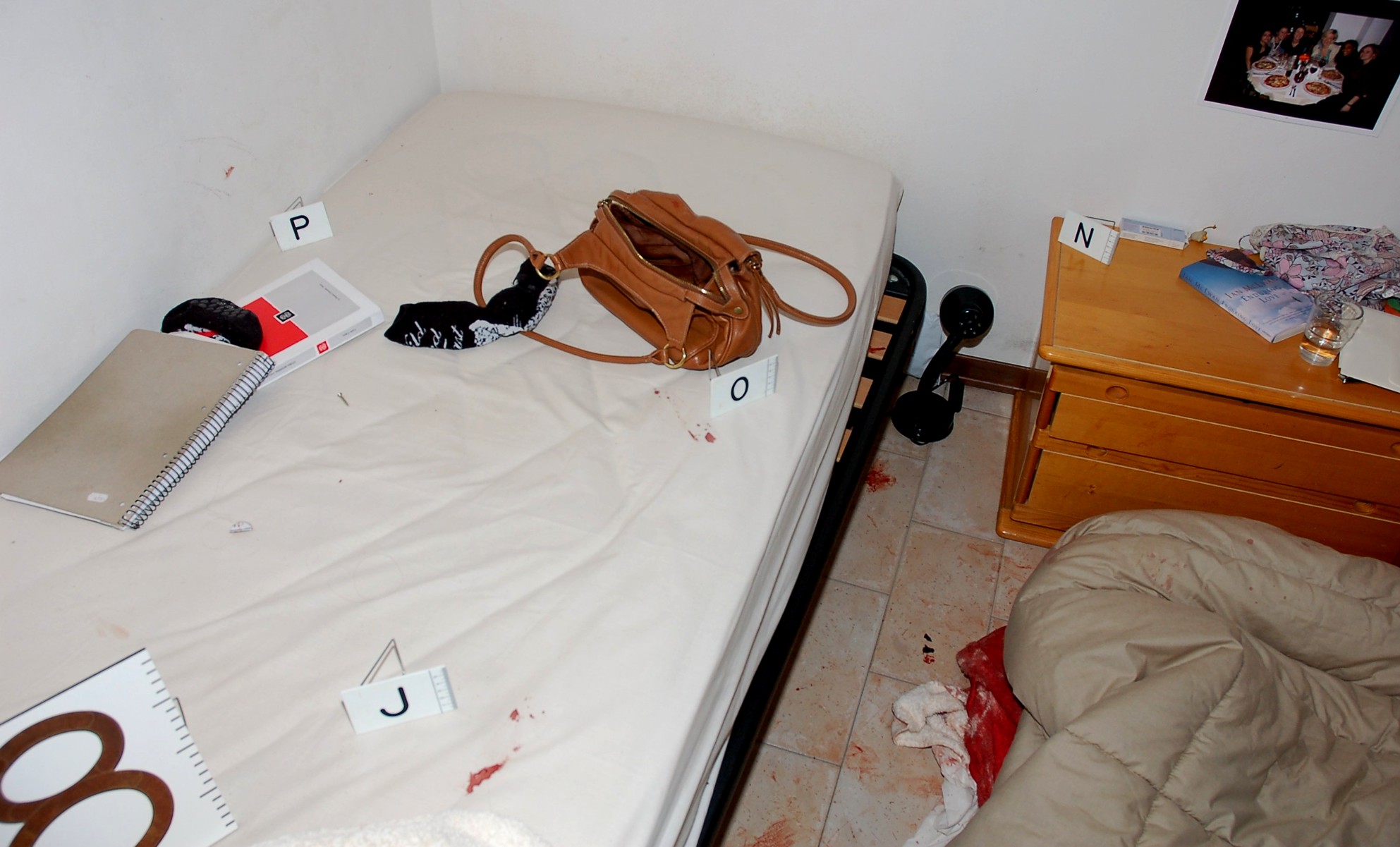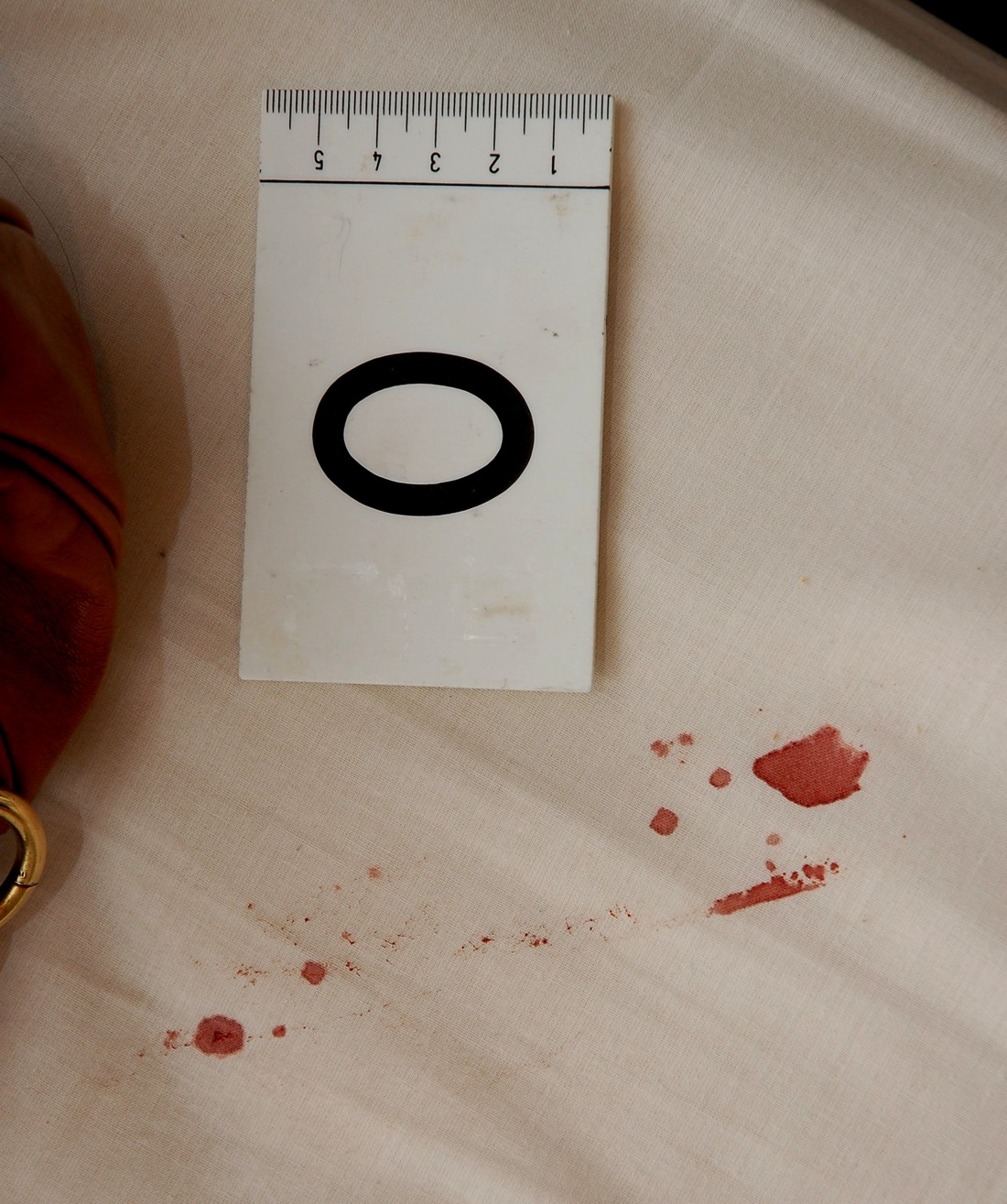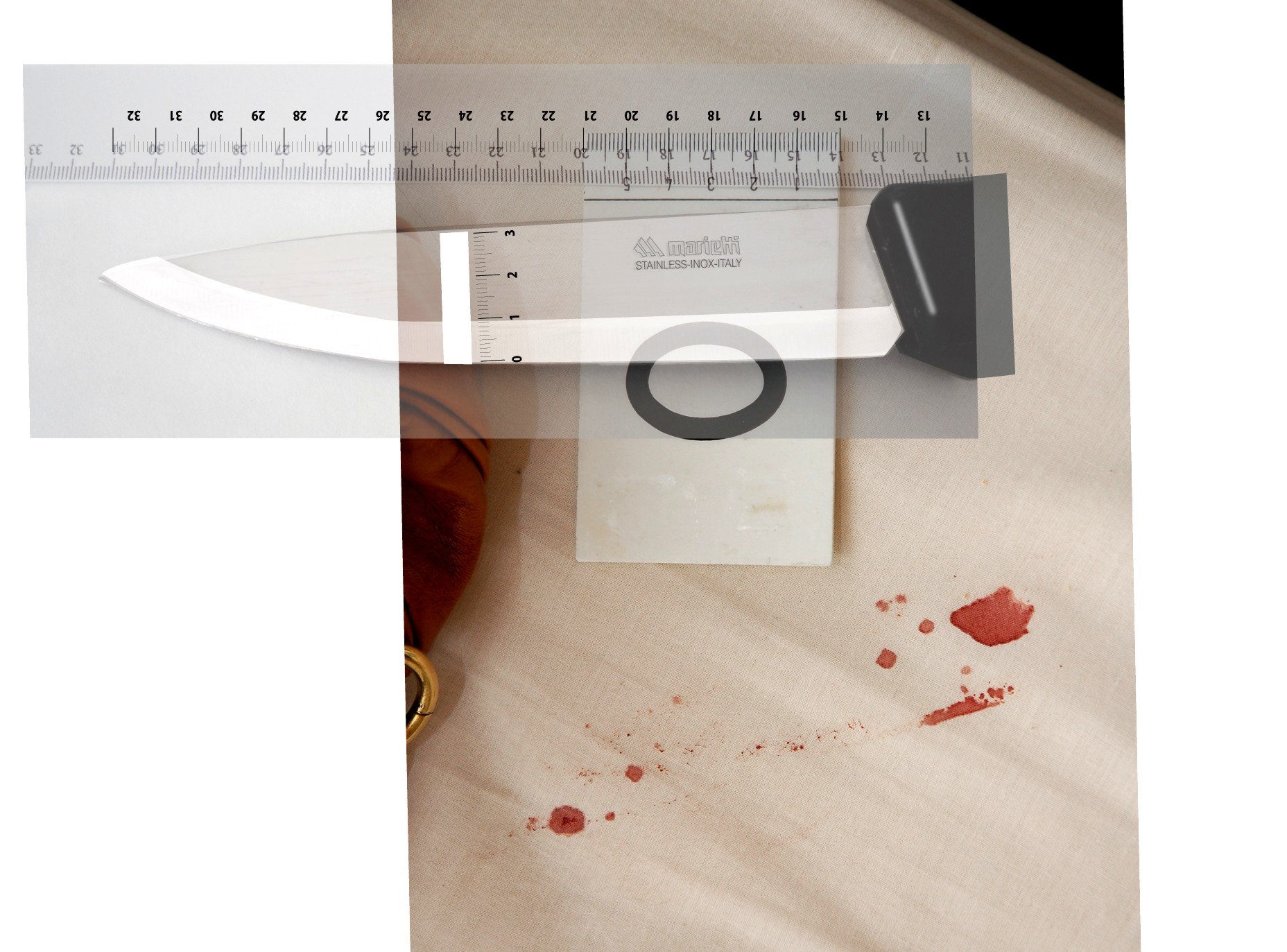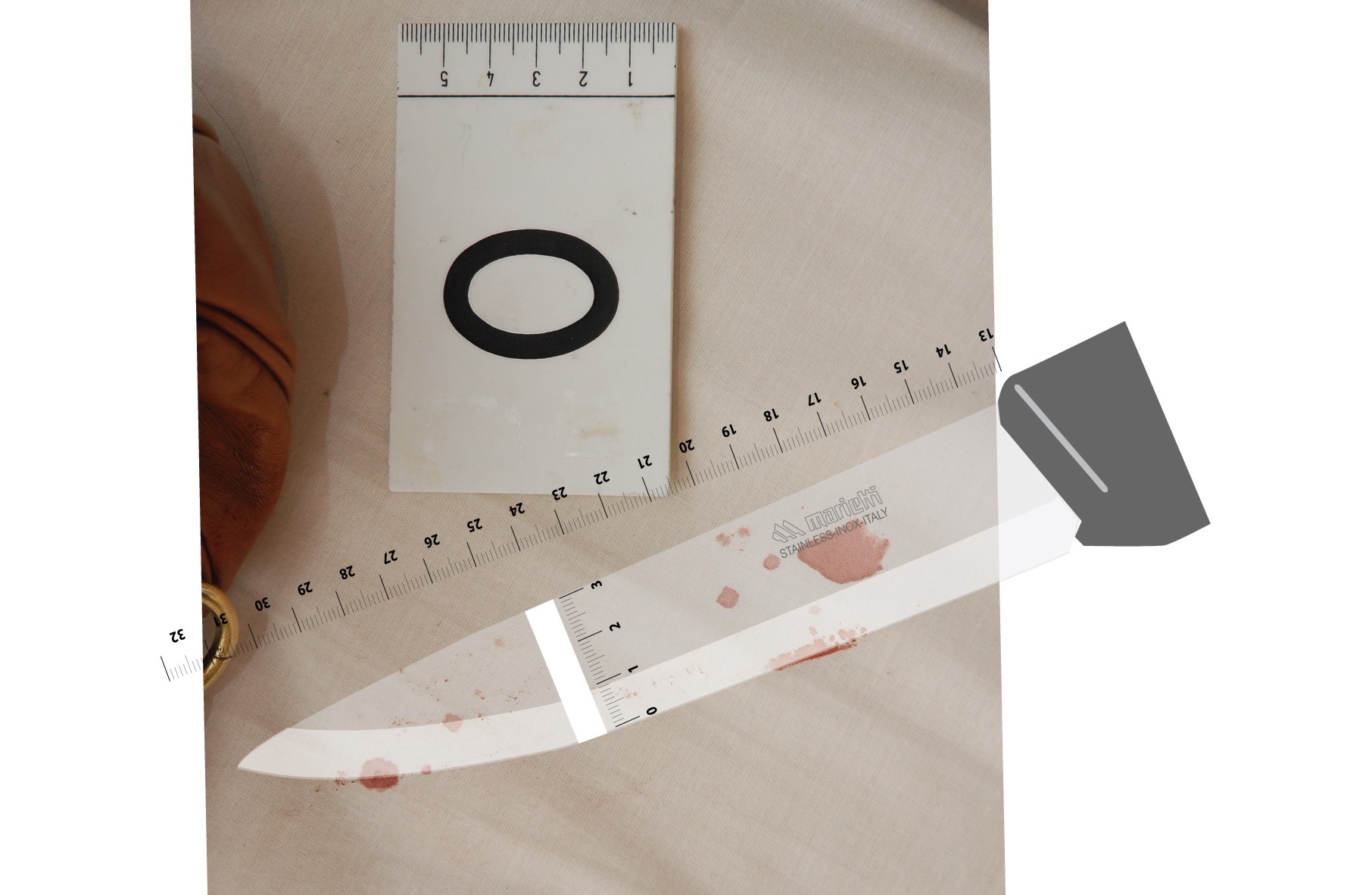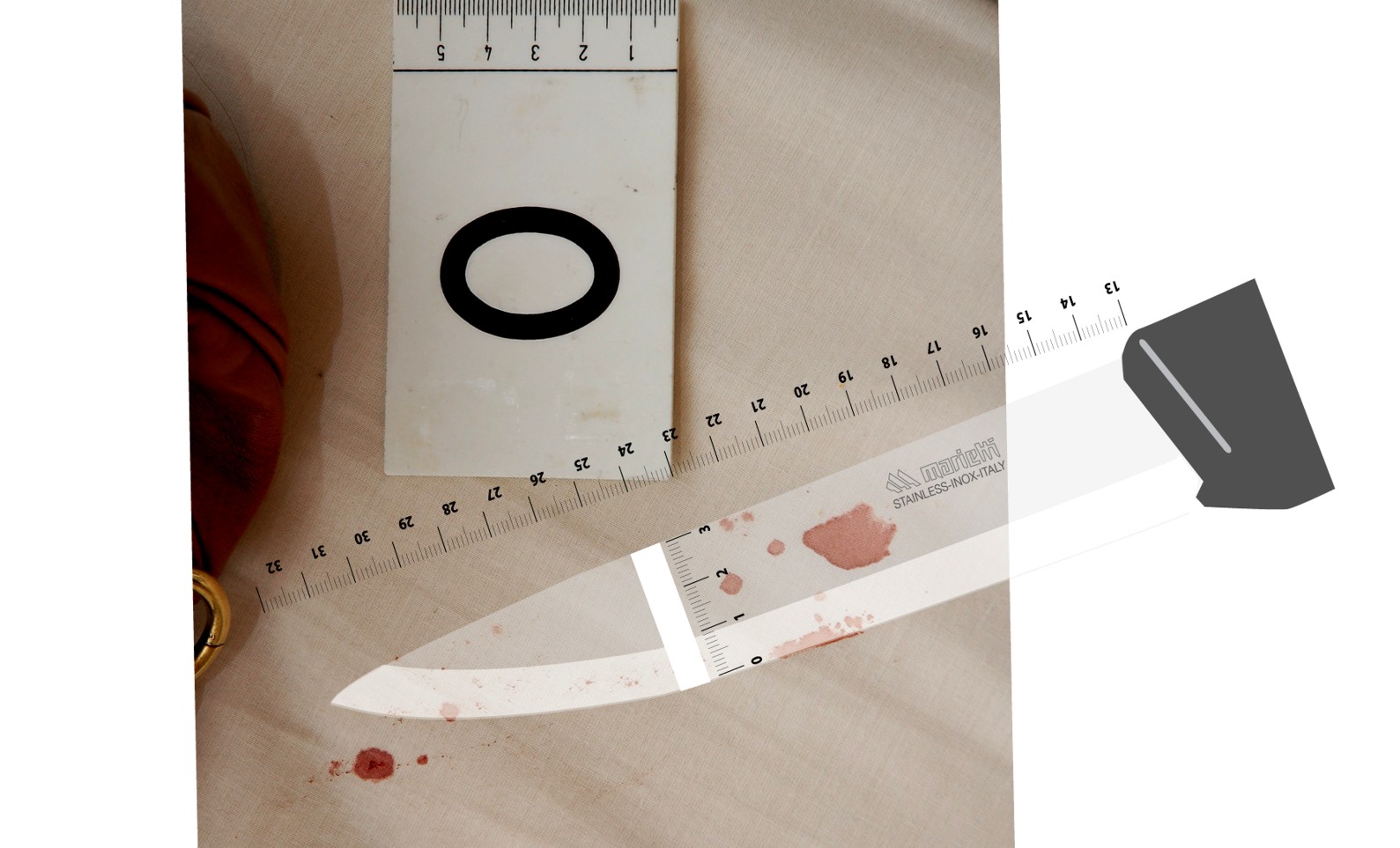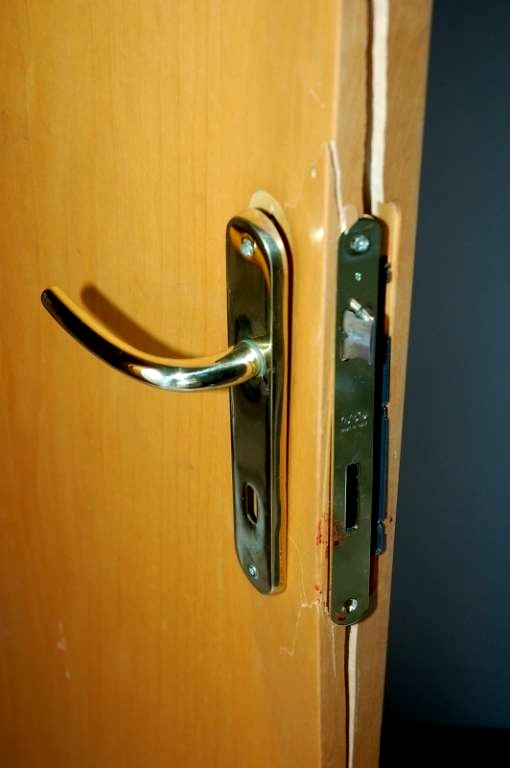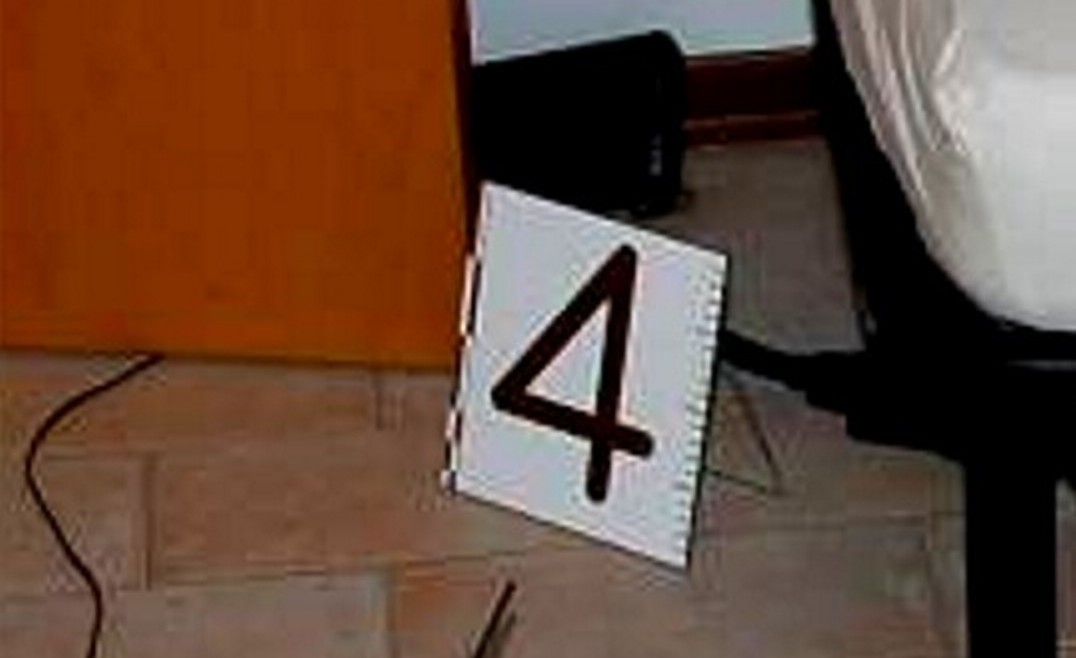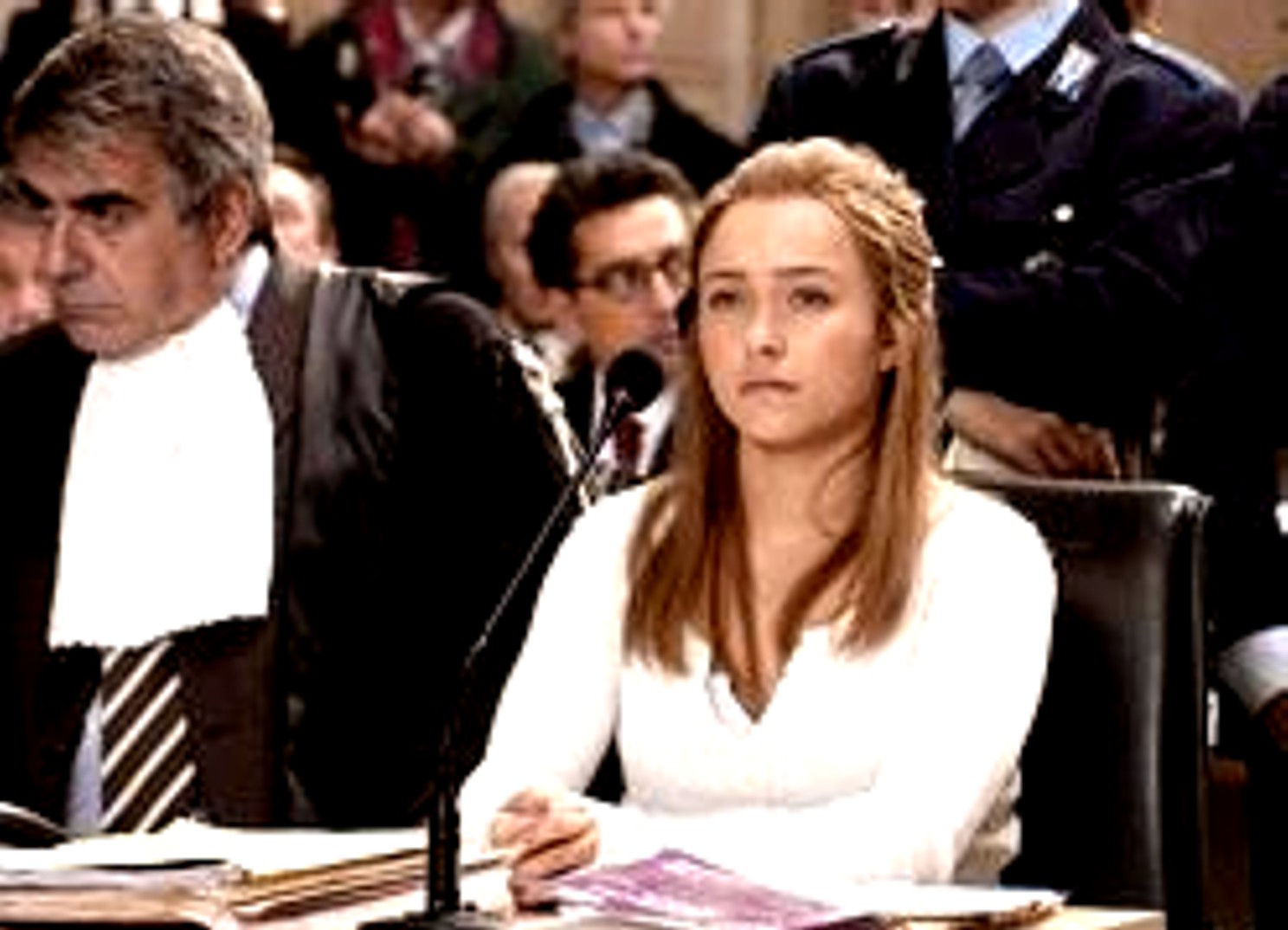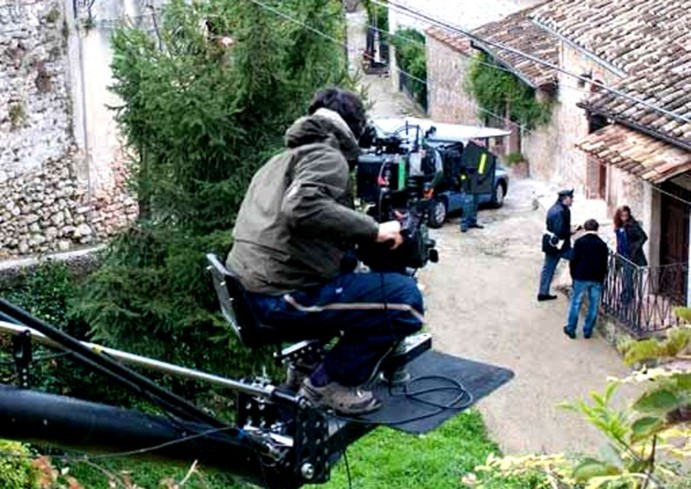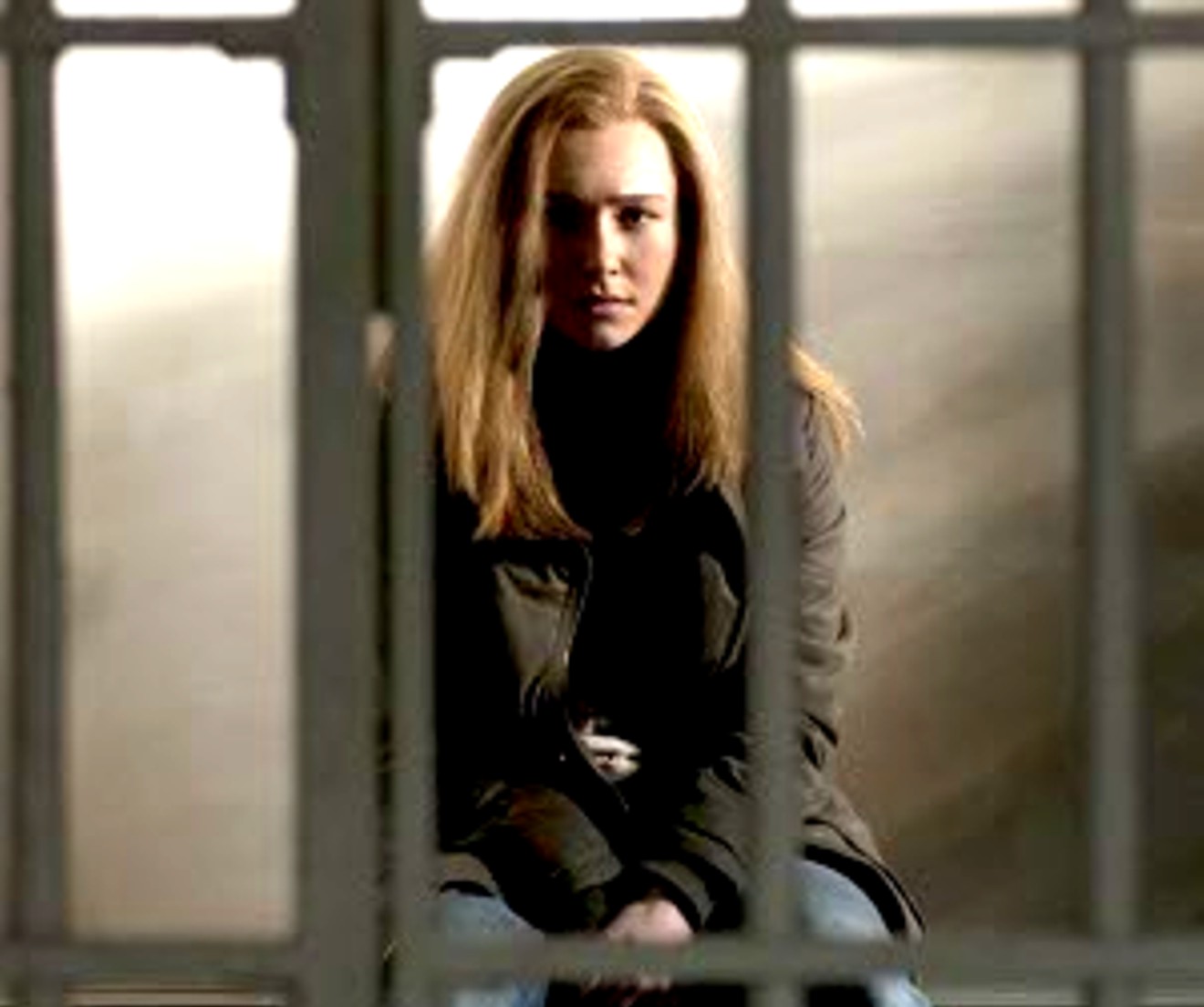
Category: The pack attack
Wednesday, April 16, 2014
The Incriminating Bathroom Evidence: Visual Analysis shows the Footprint IS Sollecito’s
Posted by Machiavelli
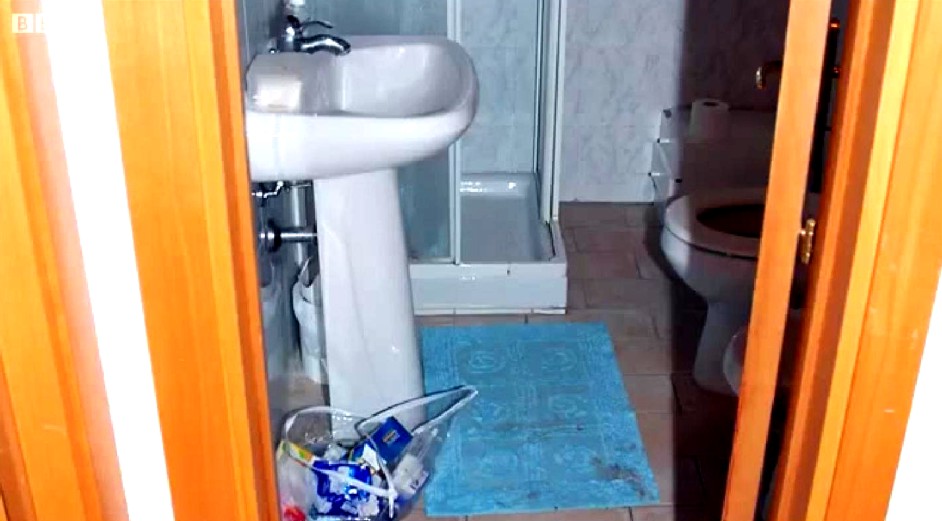
[Please click on each image for a larger and more high-resolution version]
The sheer depth and width of the hard evidence
The defenses really don’t want you to know this: in both width and depth, the full panoply of the evidence against Knox and Sollecito is absolutely overwhelming.
As we remarked in our post below there are far more and far stronger evidence points than UK and US courts normally require for conviction. But only the trial panel of judges observed anything like their full array.
The 2010 Massei Trial Report (which the Nencini Appeal court validated this past January) is a SUMMARY of what was presented to the judges in the courtroom. Those presentations in court were in turn something of a SUMMARY of the hard evidence buried in all the evidence files and the minds of witnesses.
Italian media SUMMARISED for Italians what was to be seen in the courtroom and to be read in the Massei Report. They were barely able to do even summaries for the 1/4 of all the trial hearings that were not open to the media or the public.
UK and US media for the most part didn’t even bother to provide comprehensive summaries (the very fine on-the-spot reportings of Andrea Vogt, Barbie Nadeau and Ann Wise were the main exceptions).
So in effect people in the UK and US attempting to follow the story didnt for the most part receive even a summary of a summary of a summary!
Not one US or UK newspaper or TV network translated the Micheli Report, or the vital Massei Report, or the Supreme Court appeal, or the Supreme Court outcome - only the (mostly professional) translators on PMF dot Org did all that translation.
This post is another example of how far down - beyond even Massei - it’s possible to drill into the evidence, and see it still hold up.
Some past posts on TJMK drilled down to similar depths, on the knives, on the DNA, on the mixed-blood traces, on the phone-events, on the motives and psychologies, and so on. All that evidence too all held up.
Visual analysis of the bathroom-mat footprint
This post mainly consists of high-resolution pictures and measurements. Presented like this, the pictures and measurements largely speak for themselves, and show the real strength of the bathroom-mat footprint evidence.
You will see that as SomeAlibi previously concluded using other methods, this footprint was quite undeniably Sollecito’s. It bears no similarity at all to Rudy Guede’s.
Please click on all images for larger versions in scalable PDF format
1 . [Below] the bathmat and the print, with measurement reference
2 . The bathmat print and the surrounding area
3 . The bathmat print (photo from Polizia Scientifica).
4 . The bathmat print, with vertical and horizontal sizes, from Rinaldi’s report
5. The bathmat print, photo with enhanced contrast.
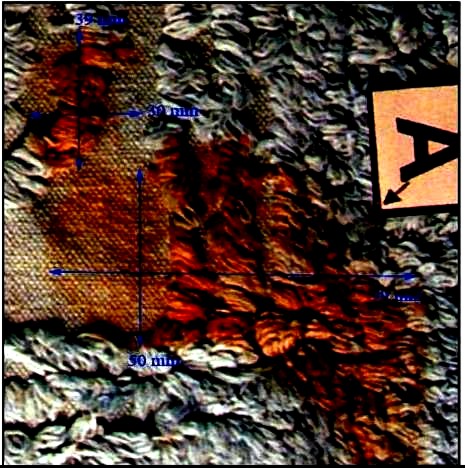
The photo above was modified by highly enhancing contrast.
6 . Enhanced contrast helps to spot some features
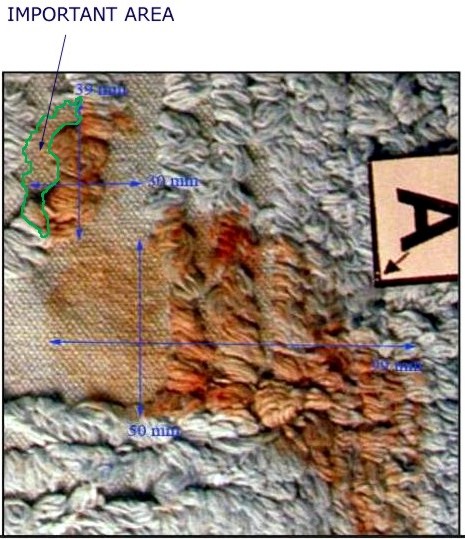
Contrast may help to highlight especially some parts of the print outline.
For example the area on the left labeled as “important area” in the picture (which was “forgotten” in the notorious photo elaborations disseminated by the ‘Friends of Amanda’ group), shows the actual left outline of the “˜big toe’ of the bathmat print.
The toe includes the area indicated in this picture (here the picture is shown again in its original colours).
7. The bathmat, with enhanced contrast
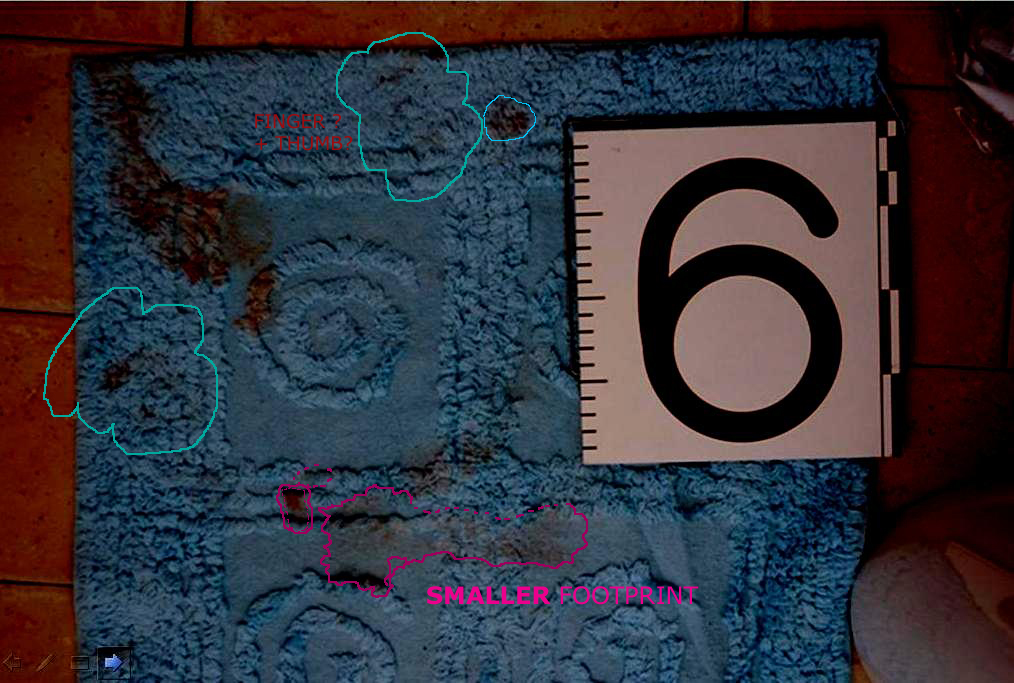
The contrasted image is showing the presence of other stains
There are other stains on the carpet (about another 10, factually situated in one half of the mat area), and also there shows a second diluted footprint (apparently from a foot of smaller size).
8. The selection of a set of red colour shades, outlined by an automatic outline generator
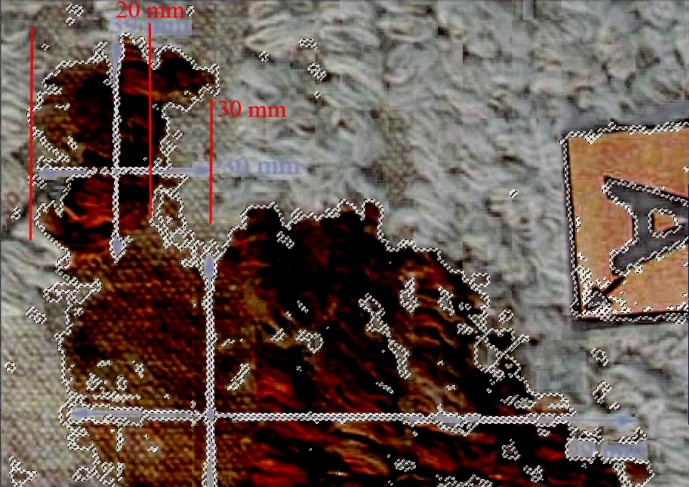
Shows the shape and the possible “˜outline’ of the stain
Reference measurements indicate the width of the “˜big toe’ in millimetres.
9 . A hand drawing of the outline (detail).
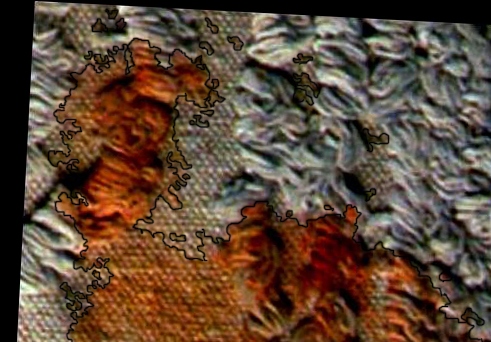
The photography above was modified
The modifications are: +28% contrast, -8% luminosity, + 20% colour saturation, from the original.
An outline has been drawn manually on the photoshop image, trying to be as faithful as possible to the actual stain.
You can notice that, apart from some minor “˜disputable’ very faint areas (such as the area between the toe and the metatarsus) there are only minimal differences between an automatically generated outline and a manually drawn one.
The shapes of the “˜big toe’ are extremely similar in both contours (images 8 and 9), in fact all meaningful features are basically identical.
We consider this manually drawn outline as good for comparison.
10 . The complete hand-drawn outline
11 . Minor detail: small dots separated from the main stain
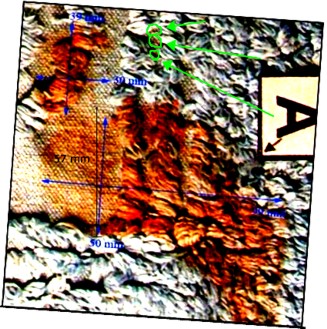
Observe the small red ‘dots’ in the picture above
Although we can’t draw any conclusion about their possible significance, we note the existence of these very small “˜spots’ of a faint red colour shade, separated from the big stain.
They are detected by the computer generated outline above, and that we also see as distinguishable with the naked eye thus we considered them in drawing manually the outline.
We don’t draw any conclusion about them; but because of their sensitive position (they may suggest a “˜small toe’ mark) we take note of them.
The green arrows in the picture point out their position (green circles).
12 . An image in electronically modified colours
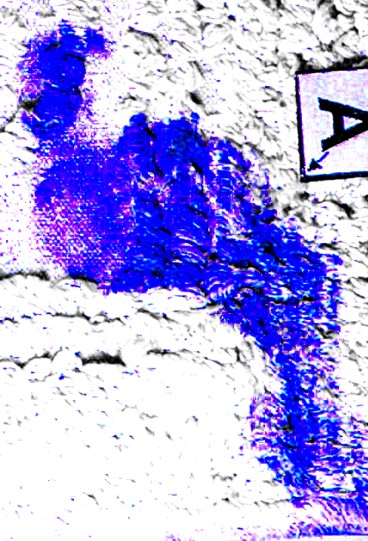
Distribution and intensity of the colouration
As a part of the preliminary study of the stain, we also produced this image above where the computer assigned an artificial colour to an array of shades of ‘red’, thus allowing to further isolate the stain from the background for further assessments about its shape.
This picture shows the distribution and intensity of the colouration. (note: the existence of some above mentioned tiny marks is recorded by this technique too)
13 . The bathmat has a spiral-shaped relief decoration
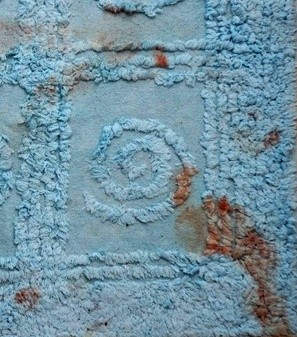
The footprint’s toe obviously balancing on top of the relief decoration.
We think the outline of the “˜toe’ mark of the bloody footprint is affected by the shape of the decoration, in particular the missing part of the toe on the right side, which is remarkably coincident with the margin of the decoration.
So that on that side there is a striking correspondence between the outline of the “˜negative area’ ““ the fabric surface around the spiral, which is lower ““ and the big toe’s outline
This indicates that the outline of that mark on that side was affected by the decoration margin, thus the print there has a “˜missing part’. So the “˜crooked’ bloody area in fact follows the margin of a larger toe.
Because of such coincidence, we can logically assume that the actual shape of the big toe mark appears to be part of a big toe, with larger surface which left its print only partly because part of its surface did not have contact with the fabric, in correspondence of the “˜negative area’.
14. The “negative area”
15. Mat decoration in relief and the toe mark
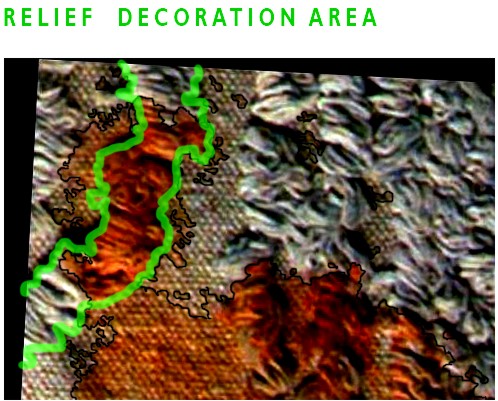
Observe above one single, unitary stain
The remarkable coincidence between the outlines of the decoration in relief and of the toe mark is shown in the picture above.
The rough contour of the print obtained through a smooth curve highlights the shape of the big toe.
Part of the relief decoration outline coincides with the toe mark outline, which shows, highlights and explains how all parts of the red toe mark, that you can see left of the relief decoration, they all belong to one single, unitary stain.
Thus we can deduce that the “missing” area on the right of the toe is determined by the decoration, and coincides with the negative area.
16. Picture (by Kermit) showing a rough shape of the stain
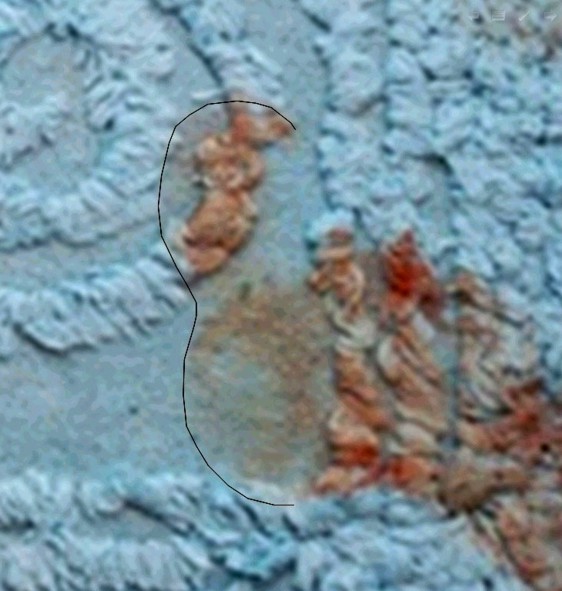
Observe shape, curvature and size
This drawing by Kermit above highlights the rough shape, curvature of left margin and overall size of the big toe.
17. Rudy Guede’s sample print
A copy of this picture together with one of Sollecito’s print at the same scale will be used for comparisons.
18 . Raffaele Sollecito’s sample print
A copy of this picture together with one of Guede’s print at the same scale will be used for comparisons.
19. Part of Rudy Guede’s sample print with Rinaldi’s reference measurements
20. Part of Sollecito’s sample print, with Rinaldi’s reference measurements:
21. Bringing all photographs down to the same scale
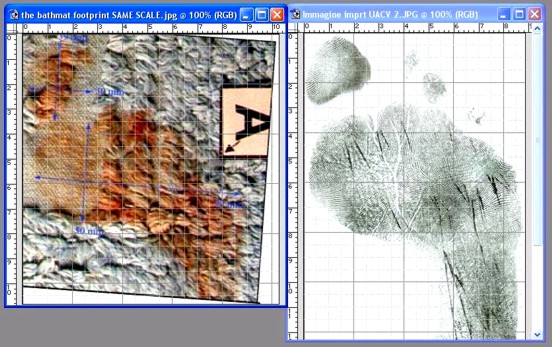
An accurate exercise of scaling was done
This was based on Rinaldi’s referenced pictures. Each one of the Rinaldi’s sample pictures has multiple measurements on several points of reference which allow a high precision determination of their scale and sizes, and thus comparison at the same scale.
In order to further increase scaling precision, the scale was calculated previously and separately for each comparative measurement in the three photos; this was done multiple times for each measurement and the average was picked in order to reduce error as for statistical measurement method.
The resulting final error in the scale is extremely small, far below a threshold of significance that could affect comparison (which was set arbitrarily at 1%, but it’s probably significantly higher, while the actual error is much lower).
In other words, the scale error that may affect your screen pictures will be definitely smaller than any possible perceivable (either significant or tolerated) difference that would be noticed or that may affect the attribution of the stain, when this is compared to the sample.
22. The hand drawn outline is shown again here
23 . The outline (matched scale) overlapped on Sollecito’s sample footprint
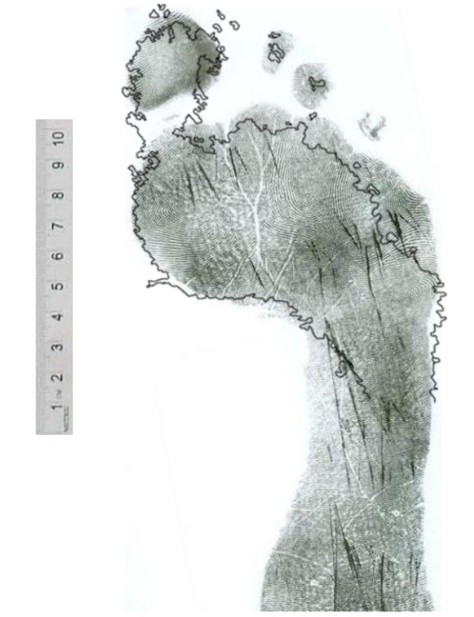
The array of compatibilities with Sollecito
The bathmat stain does not seem to have major incompatibilities with Sollecito’s print; it shows rather an array of compatibilities that can be perceived visually.
One interesting feature is the shape, size and position of a ‘big toe’, that appears as a remarkable coincidence; the toe also has a kind of cleft (see 28 below) on the curvature of its left margin. Another outstanding coincidence is the curvature of the plantar arch on the left.
24 . The same outline overlapped on Guede’s footprint
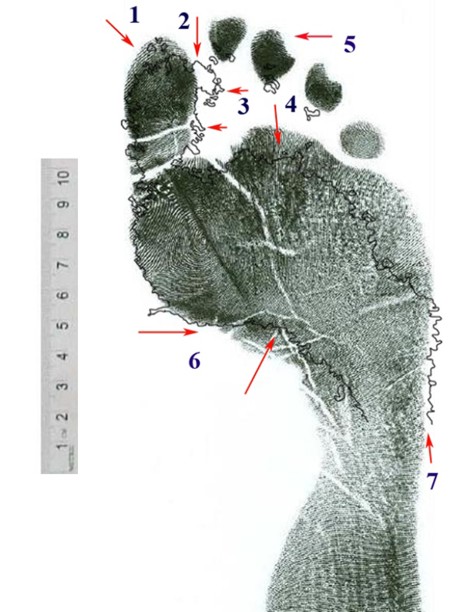
Compare with Guede’s - matched scale.
If you look at the overlapping of the stain outline (see pic 22.) with the sample of Guede’s print (see pics 17. 19.), you may notice 7 major differences, showing a failure of compatibility. Those differences are indicated by numbers (1-7) in the picture .
Each one indicates an area of major difference between the outline of the bathmat stain and the outline of Guede’s sample print. Those measurement differences are remarkably larger than those that can be detected on the overlapping with Sollecito’s sample print.
On the other hand, the compatibility between Sollecito’s print and some very peculiar aspects of the bathmat print (such as a 30mm wide and short toe) were absolutely remarkable.
The differences between the bathmat stain and Guede’s print are :
1) Toe mark of stain is significantly SHORTER than the big toe in Guede’s sample print (a difference of about 7 millimetres). Some people may want to attempt an objection, by suggesting that such a difference may be just a consequence of the position chosen for the overlapping, that maybe the bathmat print was just positioned too low in the picture, the problem may be solved by shifting it up about 7 millimeters so as to make the tip of the bathmat toe ‘coincide’ with the tip of Guede’s print toe.
However, such objection wouldn’t work; it’s a wrong argument. In fact the only possibly correct position for overlapping the bathmat stain outline is determined by the left curvature of the ball of feet and plantar arch (the area of the picture near number 6), which is by the way the most clearly outlined part of the bathmat stain. If you shift the bathmat stain upwards, the outline will miss the match with the curvature of the left margin of the ball of the feet. You will notice that the plantar arch in this area is already very incompatible with Guede’s plantar arch. It tends to become even more incompatible the more you shift the bathmat stain outline towards the toe.
The problem has no solution, since the more you shift the stain outline upwards (in the direction of the toe) in an attempt to make it look more ‘compatible’ with the length of Guede’s toe (or with an upper margin) the more it will become incompatible with the plantar arch. In order to limit the incompatibility of the plantar arch, and in order to keep an overlapping of at least the left margin of the ball of the feet, you need to place it as shown in the picture, this is the position of ‘maximum’ compatibility between the bathmat stain and Guede’s print. Conclusion: the bathmat toe is too short.
2) Toe mark of stain is TOO WIDE (30 mm). It is much wider (30 mm) than Guede’s toe. The number 2. indicates the protruding mark at the upper right, the mark which Giulia Bongiorno desperately insisted on calling a “second toe” mark. In fact, not only would the mark miss completely any hypothetical Guede’s ‘second toe’ in any possible position of the print; also you may notice (highlighted by pics 8. and 9.) how it is not a “mark” itself, but actually it just part of the same area which is entirely continuous in shape and coloration with the rest of the toe mark, and - the most remarkable feature - its right outline is coincident with the outline of the spiral-shaped relief decoration, so that you can reasonably conclude that it is determined by that (the missing area at the lower right of the ‘big toe’ is determined by the existence of the “negative area” of the bathmat decoration).
Conclusion: the bathmat stain has a wider toe mark, however one likes to call it (“big toe”, or “big toe + second toe”) that fails to match any possible part of Guede’s print. The bathmat print is clearly different and incompatible with Guede’s print. It simply cannot be overlapped to any part of Guede’s sample print. Such area is a very significant difference that points outright to incompatibility between the stain and Guede’s print.
3) The toe mark is larger also in the area located at the lower portion of the toe. The toe of the bathmat print in fact has a ‘right margin’ which actually has some additional small marks, small drops protruding towards the right, like droplets maybe produced by the wet cotton fibres of the part in relief which protrude towards the right. This tends to suggest the toe area of the stain may in fact be considered wider: the object that produced it was definitely wider than 22mm, in this area of the toe as well. So also a look at this area confirms that the bathmat stain is wider than 22-23 mm (more towards 30 mm) not just when measured at the upper corner (number 2.) but also at its “lower” parts; here, the small marks caused by the liquid suggest that a larger surface has squeezed liquid from some fabric threads leaving some trace also on the lower area.
4) Bigger incompatibility of Guede on the metatarsus front outline. This area is the front outline of metatarsus: the stain is almost 1cm shorter than Guede’s metatarsus. This happens when you chose the overlapping so as to make the left outline and plantar arch (6.) of metatarsus coincide, as in the picture. Sollecito’s sample print also shows some difference from the stain in this area (pic. 23.) but the difference between the stain and Sollecito’s print is significantly smaller than what you can see in Guede’s print.
5) There are NO SMALL TOES in the bathmat stain. Small toes are completely absent from the bathmat stain (while the tiny blood marks around the stain don’t coincide with their expected position if it was Guede’s print). Such lack of small toes is a peculiarity of the bathmat print. This is a remarkable difference from Guede’s print, and at the same time, a considerable analogy with Sollecito’s print. In fact one outstanding feature of Guede’s print is the evidence that Guede places a big load of weight on his small toes while instead Sollecito has a posture with a weight distribution with the contrary tendency, and obviously he almost does not touch the ground with his small toes.
Thus, Guede’s small toes are all very well pressed on the ground and thus, we can reasonably infer they are somehow naturally likely to get wet if he steps on any wet surface, and anyway they should get wet for sure if the foot is immersed in water or washed (the foot that left the bathmat print must have been immersed in bloody water). The murderer supposedly washed his foot then stepped on the bathmat. In order to attribute the print to Guede we should assume that Guede “forgot” to touch the carpet with his small toes (while instead he puts a lot of weight on them) or that he managed to not rinse them.
6) The outline of the stain has a PLANTAR ARCH that COINCIDES, by curvature and angle, with the plantar arch in Sollecito’s print, while instead it is very different from the plantar arch of Guede’s print.
7) The stain is larger than Guede’s print metatarsus as visible in the right area of the stain. The difference is rather significant, almost half a centimetre, that is bigger than the difference with Sollecito’s print which instead coincides for a trait. This difference cannot be “solved” in any way since, even if one wanted to claim that the scale is wrong and that the stain should be sized down, this would make the toe, already too short (as in 1.) become even shorter.
If instead the toe length is adjusted the metatarsus becomes even less compatible with Guede. We recall that Massei found that Guede’s feet had a print overall more slender than Sollecito’s.
25 . Other features:
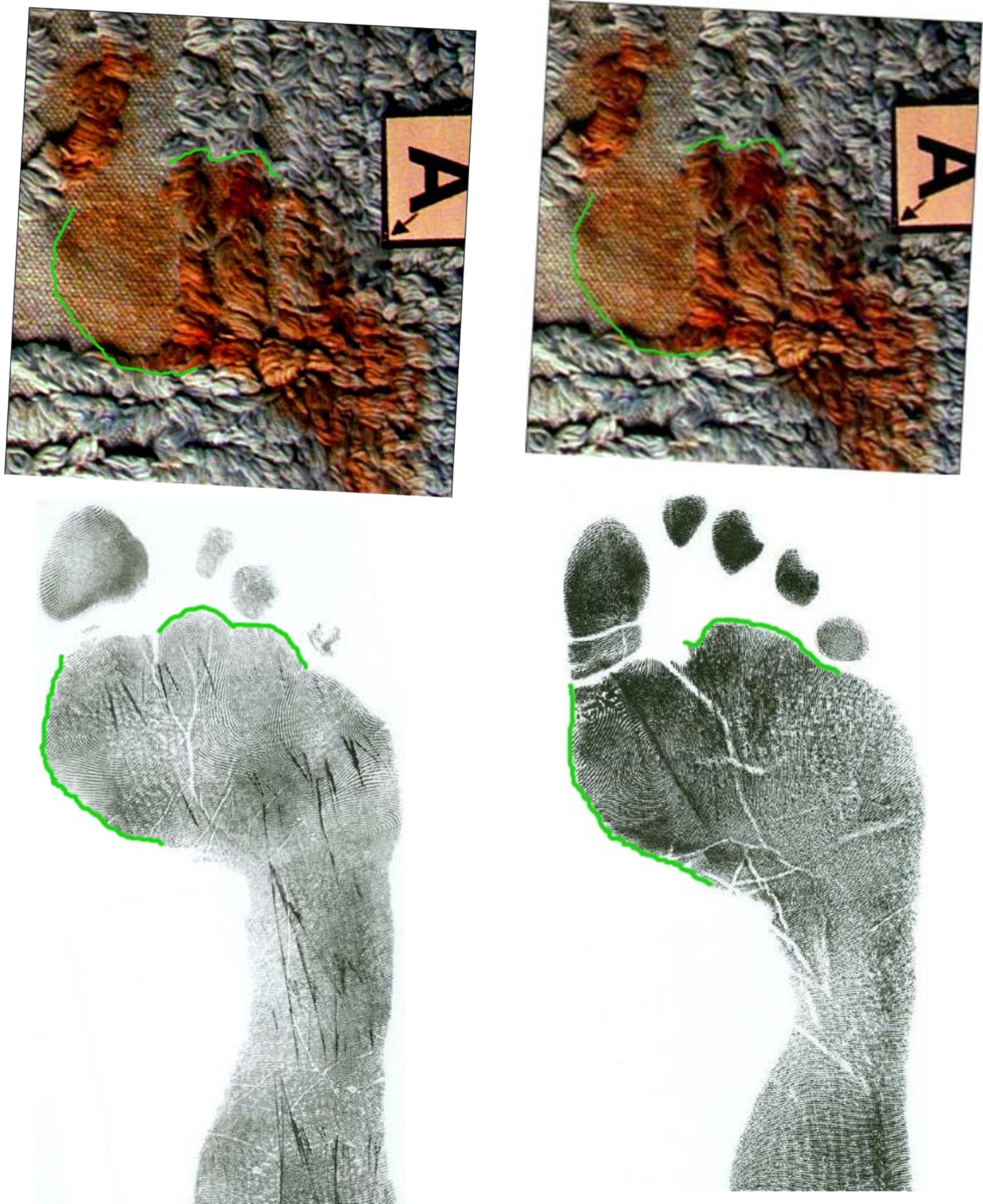
Curvatures of plantar arch are very different
The plantar arch curvature, highlighted in two different drawings (the second highlights also the upper outline “hunches”); the plantar arches in the two sample prints of Sollecito and Guede are shown below. The curvatures of plantar arch are very different.
26. The outline curvature generates different angles
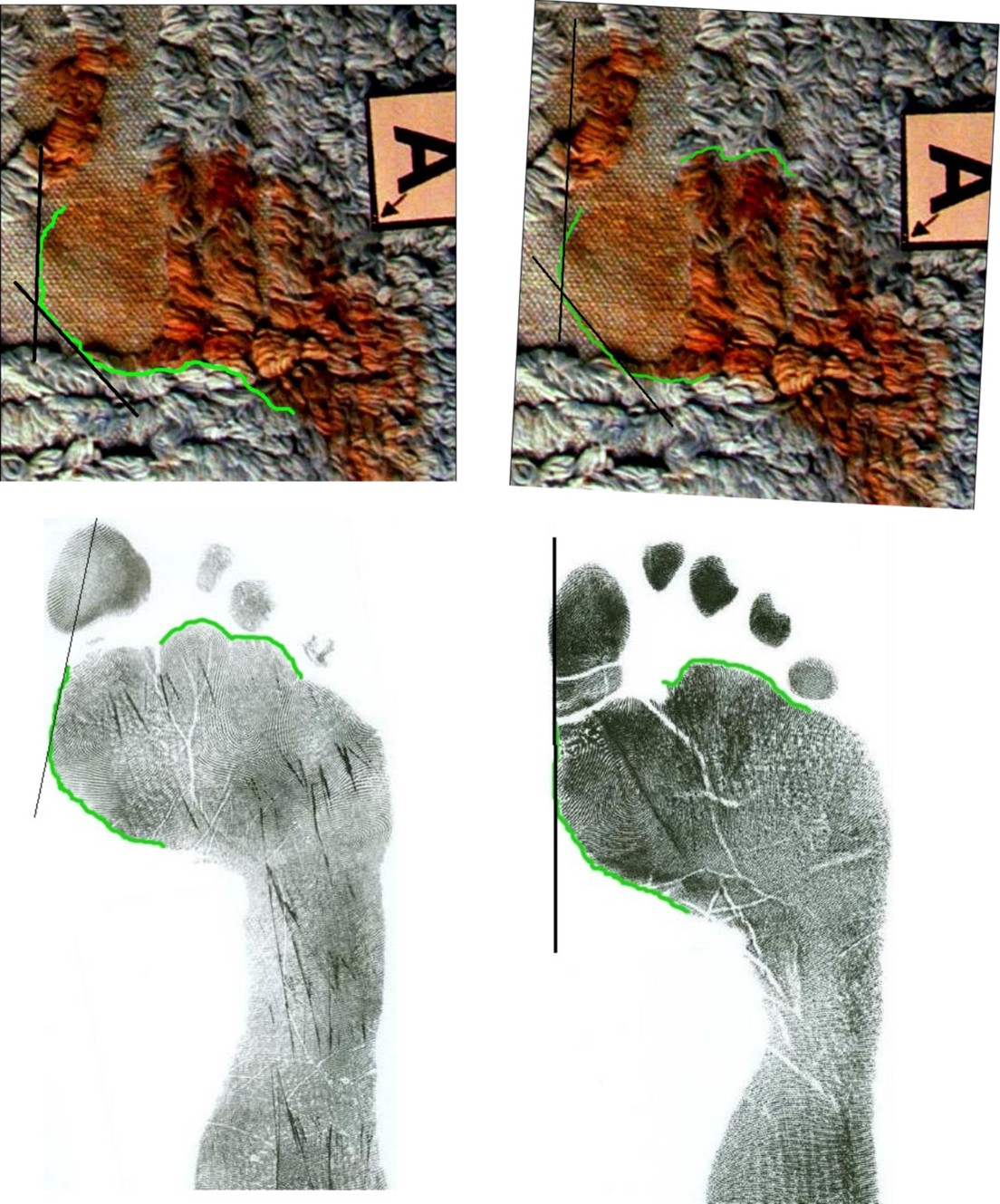
Sollecito’s and Guede’s plantar arch curvatures have very different angles. Also the left outline of metatarsus maintains a different curvature. Sollecito’s outline has an angle (see outline tangent) intersecting the toe (the metatarsus has a “bunion”); in Guede’s print there is basically no intersection, the outline and the toe form almost a straight line.
27 . Plantar arch curvature angle differs between Sollecito and Guede
If you consider the vertical axis of the sample footprint, and its orthogonal line, you may notice how the plantar arch curvatures of the two prints accomplish different angles: the two angles are VERY different, not just three or four degrees.
The (too) narrow angle of Sollecito’s plantar arch probably has a relation with the protruding outline and angle seen in pic 26., and seems related to a hallux valgus (which Guede does not have).
28 . The “cleft” on the left side of the stain
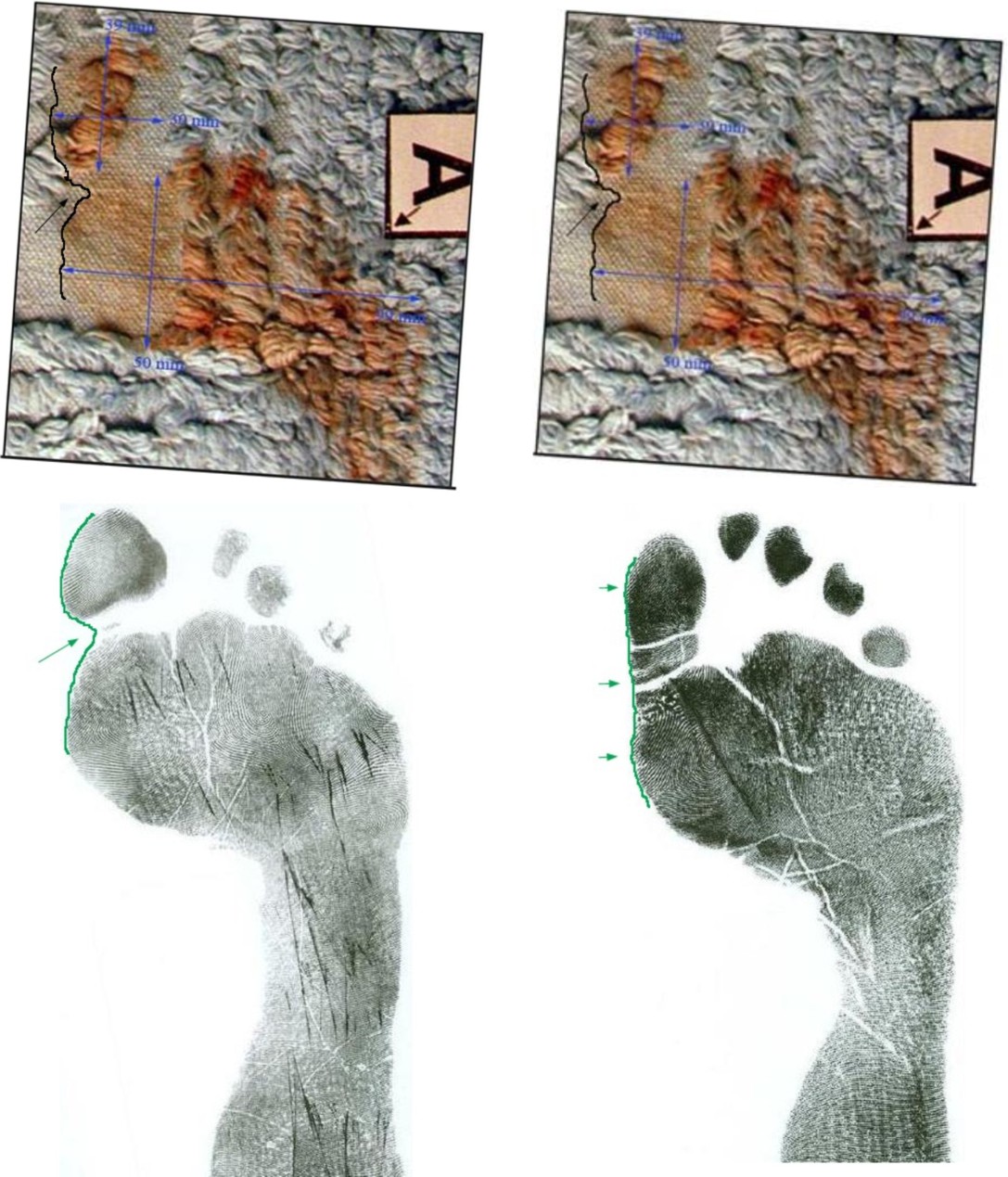
The “cleft” on the left side
This has a correspondence with one sample print, not so with the other.
29 . Table of metric comparison (by SomeAlibi)
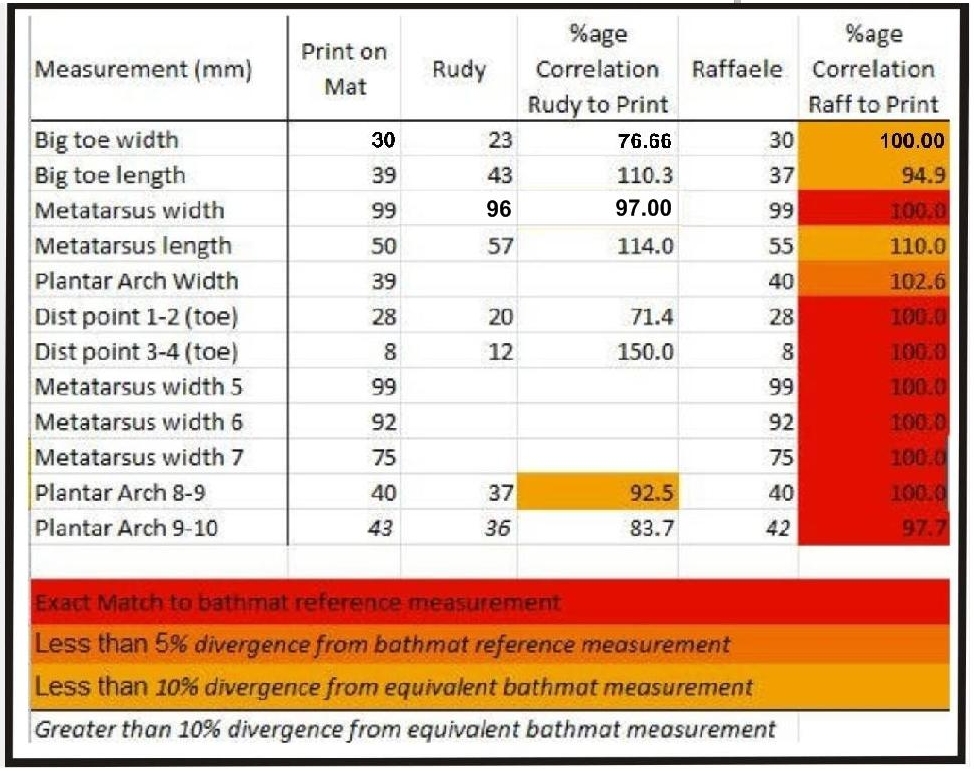
SomeAlibi’s post of a year ago
Comparison of measurements and analysis of correspondence degree of bathmat print, with both Guede’s and Sollecito’s sample prints.
Monday, January 27, 2014
An Investigation Into The Large Knife Provides Further Proof That This Was THE Knife
Posted by Ergon
Overview
This is the first report of an investigation (the second part follows soon) of the kitchen knife used in the murder of Meredith Kercher, RIP.
Specifically its compatibility with the imprint of a bloody knife found by police investigators on her bed under-sheet which as you will see here seems possible to prove.
Two other recent posts also concentrated on aspects of the knife as strong proof: (1) proof of both Knox and Kercher DNA and (2) proof from the throat wounds.
- Reference files are from very high definition crime scene photos not in general circulation.
- Grateful thanks to the volunteers of the Meredith Kercher community who assisted in this production
Florence Court of Appeals
This is our poster Machiavelli, tweeting from the Florence courtroom on November 26, 2013:
“(Prosecutor Alessandro) Crini stated that this kitchen knife was compatible with the knife print on Meredith’s bed sheet”.
And this is from the defense summing up on January 09, 2014:
Bongiorno: “It’s too big, not the murder weapon.”
“Bongiorno shows a picture with an envisioned “knife” (pocket knife belonging to Guede?) together with the print on the bed sheet.”
“Nobody brings a “small blow with a big knife” “You don’t use half of a big knife” (she says)
Genesis of an investigation:
To recap: evidence was been presented at the Massei court of the first instance, which accepted that the kitchen knife, containing both Meredith Kercher’s DNA on the blade (trace B) and Amanda Knox’s DNA on the handle (trace A) was the weapon that struck the fatal blow to Meredith Kercher’s throat.
At some point after the attack, the perpetrator, Amanda Knox, puts it down on the bed, leaving “hematic stains” (bloody imprints) on the mattress.
The court concludes the shape of the imprints are compatible with the kitchen knife. It also concludes, based on the size of a lesser wound that a second, smaller knife caused the wound on the other side of the neck, and, the impossibility of accepting that a single weapon inflicted both wounds.
This is what it boils down to now, as we come to the final arguments of this case on January 30, with a decision to be handed down by the court later in the day:
- Was the kitchen knife found in Raffaele Sollecito’s kitchen the murder weapon that killed Meredith Kercher on November 01, 2007?
- Did the killer leave behind proof in the form of bloody imprints on the under sheet covering Meredith’s bed?
- And is the defense trying to divert attention away from it, even though the image on the bed fits the dimensions of the kitchen knife?
- And pointing to a second knife, not ever found?
This article (to be followed by part II) was prepared to offer answers to these questions.
Methods used
As someone with a keen interest in photography, I know we see things in photographs that are not always apparent to the naked eye.
Where before we had all been misled by low definition photographs released by the defense to obscure incriminating details, I was able to obtain and view the high definition photographs shown here that proved that indeed, the bed imprints matched the seized kitchen knife, exhibit 36.
These photographs, first posted at Perugia Murder File Evidence Files have been circulating for some time, with members trying to match the knife to the bed imprints, but not, in my opinion, being able to match it exactly.
First, note that the killer placed a knife on two separate locations on the bed, marked by reference cards “J”, and “O”. (Reference photos below.)
I discarded “J”, because there was too much blood there to form an accurate measurement. The killer lifted the knife and then placed it at “O”, which gave a better image, but even then, did not match exactly. Still, it was clear the images looked like a kitchen, and not, a pocket knife as alleged by the defense.
Looking at the reference photo, I saw a double image of a knife blade at “O”. (see where there’s a curved edge of the blade? That’s what convinced me there might be a double image there)
Conclusion reached
My opinion is the knife shifted slightly when it was placed there, hence the double image, which now made a perfect match with the kitchen knife, in both instances (see reference photos).
So I got a professional illustrator and other skilled people people to do the scale drawings and produce the video you see above which seems to provide conclusive proof the murder knife was placed on the bed.
Reference photos:
Image 1 above (click for larger image): Bed II (Image J and O on under sheet, shot November 02, 2007)
Image 2 above (click for larger image): Knife II (Image O on under sheet, shot November 02, 2007)
Image 3 above (click for larger image): FOTO5BIS (Conti-Vecchiotti lab, Mar. 22, 2011)
Image 4 above (click for larger image): Knife-Bed-Vector-AllScales (To prove the scales used to match the images)
Image 5 above (click for larger image): Knife-pos-lower-hi (The knife’s first resting position at “O”)
Image 6 above (click for larger image): Knife-pos-upper-hi (The knife’s final resting position at “O”)
Next steps
There are only four more days left till the Florence Appeals Court under Judge Nencini issues its verdict. It must of course consider ALL the evidence, of which there is a preponderance that indeed suggests the verdict will, as would be proper, be guilty as charged.
Part II will be ready ASAP. It will be a recap of Massei on the knife, and how the defense continually tried to divert us away from the knife image by saying it did not fit the dimensions of the major wound. Also will have Frank Sfarzo’s misdirection and Bruce Fischer’s amateurish attempts to prove that Rudy Guede caused the knife wounds.
Happy as always to do my share for justice for Meredith Kercher.
Wednesday, July 24, 2013
How The Clean-Up And The Locked Door Contribute To The Very Strong Case For Guilt
Posted by James Raper
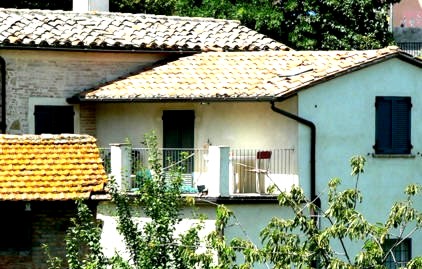
On the 30th September the appeals of Amanda Knox and Raffele Sollecito against the convictions they received at the first instance trial will resume, this time in Florence.
This follows the annulment by the Supreme Court of the acquittal verdicts rendered by the Appeal Court presided over by Judge Pratillo Hellmann. There is one conviction not under appeal. This is Knox’s conviction for calunnia, which is now definite.
They are therefore both currently convicted of murder and sexual assault, and a number of lesser charges, amongst which there is the simulation of a burglary “to ensure impunity for themselves from the felonies of murder and sexual assault, attempting to attribute the responsibility for them to persons unknown who penetrated the apartment to this end”.
There is one activity, for which there is evidence, with which they were not charged (perhaps either because it was redundant or not a criminal offence) though this was likewise to ensure impunity for themselves.
This is the partial clean up at the cottage and it is this with which I intend to deal. I want to highlight salient observations which have been under discussion here and elsewhere and some of which may be well known to readers, but perhaps some not, or have been forgotten about. Once again, in many cases, I am merely a conduit for the observations of others, not least the first instance trial judge Giancarlo Massei.
So let”˜s consider the observations and in doing so we can also throw some more light on the lone wolf theory.
1. Take a look at the bloody footprint
This is, of course, the bloody footprint on the bathmat in the small bathroom right next to Meredith’s room.
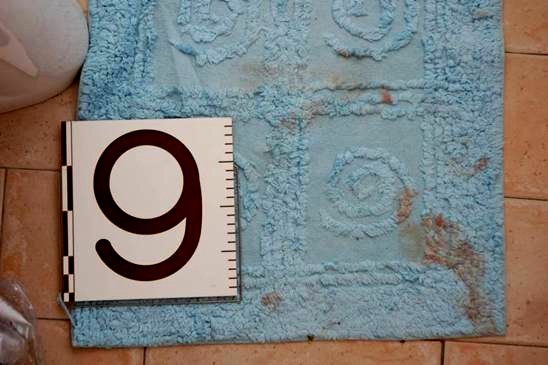
The heel of the right foot, if it had blood on it, is missing from where it should be on the tiled floor. It is difficult to imagine, given that the imprint of the foot on the mat is contiguous with the edge of the mat, that there was not at least some blood on the remainder of the foot such that there must have been at least some blood deposited on the floor.
Just as difficult to imagine that casual shuffling about on the bathmat would have removed the blood so as to render it “invisible” to the use of luminol.
Of equal relevance is that there were no connecting bloody footprints. Why not?
The defences have an improbable theory - that Guede, despite his homicidal rage, was smart enough to hop about on his left foot with a clean shoe on, and the other bare but covered in blood, and that having by this means entered the bathroom and washed his bloody right foot, disastrously leaving his (supposed) imprint there in the process, he then returned to Meredith’s bedroom inadvertently standing in blood with his left shoe and leaving with a trail of bloody left shoe prints - in which case the exercise of washing his foot was entirely in vain, on two counts, after all that careful hopping around.
Neither is it entirely clear why his right shoe came off in the first place.
It is far more probable that the inevitable bloody prints were deliberately and carefully removed. The reason for doing this was not just to conceal who would have made them (the print on the bathmat was, after all, left in situ) but, from a visual perspective, to conceal any blood that might be noticeable and alarming to anyone approaching Meredith’s room. Guede’s bloody shoeprints in the corridor were visible but only on close inspection.
2. Take a look at the bathroom door
Specifically the internal (hinge) side of the bathroom door. Take a look at this photograph.
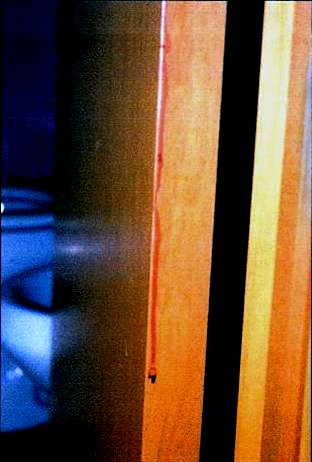
We see a long streak of dried blood. Clearly the blood has flowed some distance under the influence of gravity and we can see that it looks slightly diluted, with red corpuscles gathering towards the tip of the streak. A drip of that size does not appear from nowhere.
Indeed it is difficult to imagine how the blood got there unless it was part of a larger area of blood which most likely was on the face of the door and which was swiped to the right and over the edge of the face of the door. The cloth or towel used to do this was wet accounting for the slight dilution and length of the streak.
3. Take a look at Meredith’s door
It is interesting, is it not, that there is blood on the inside but not on the outside? The outside:
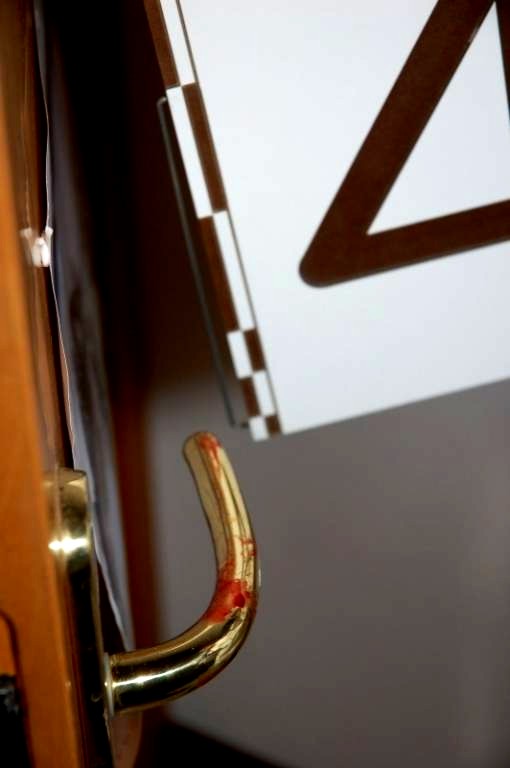
It is difficult to see how and why Guede touched the inside handle with a bloody hand (was it shut and if so, why?) and then closed the door to lock it without leaving a trace on the outside face of the door. Possibly he might have changed hands. The answer might also be that he visited the bathroom to wash his hand as well as his foot, save that none of his DNA was recovered from the spots and streaks of diluted blood in the washbasin, whereas Knox’s DNA was. All the more surprising given that Guede shed his DNA in Meredith’s room.
We see some blood on the edge of the door which again might be the remnant of a trace on the outside face.
4. Take a look at Amanda Knox’s lamp.
This was found inside Meredith’s room behind the door. Meredith also had a similar lamp which was resting on it’s base on the floor by her bedside table.
The presence and location of Knox’s lamp is obviously suspicious. Had Meredith borrowed Amanda’s lamp because her own was not working, then it would not have been in the position it was found but on or more likely knocked over and lying beside the bedside table since the violence appears to have been concentrated in that area of the room.
Had Meredith’s lamp been on the bedside table then likewise it too would most likely have been knocked over in her life and death struggle with her sole assailant (there are blood streaks on the wall just above) and it would not have ended up sitting upright on it’s base.
Both lamps were probably used to check the floor of Meredith’s room after the event and Knox’s lamp was probably sitting upright until it was knocked over by the door being forced open.
This is Meredith’s lamp by the bedside table.
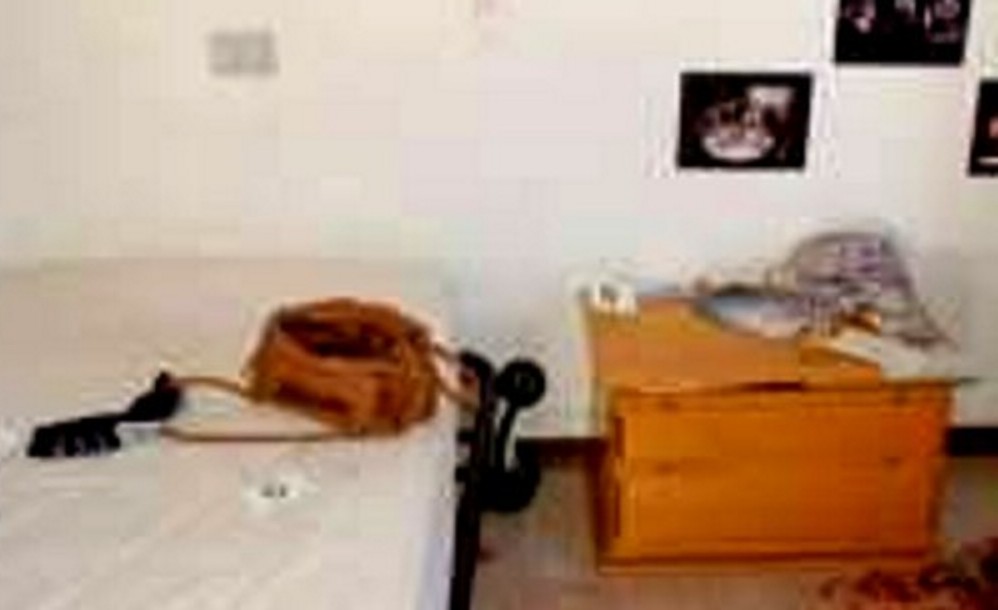
And this is Knox’s lamp by the foot of the bed.
5. Take a look at what luminol revealed
We can state with confidence that luminol (extremely sensitive to and typically used to identify blood that has been wiped or washed away) discovered :-
(a) three bare footprint attributable to Knox, one in her bedroom and two in the corridor, and
(b) two instances of the mixed DNA of Meredith and Knox, one in Filomena’s bedroom and one in the corridor.
(c) a footprint attributed to Sollecito in the corridor.
I have covered a number of elements strongly suggesting that there was at least a partial clean up, not of “invisible DNA” as the Groupies like to mock, but of what would have probably in some cases have been noticeable deposits of blood that would have attracted the eye of anyone entering the cottage and which would certainly have alarmed the observer as being difficult to explain.
Spots of and footprints in blood, not just in the bathroom but outside it, a locked bedroom door with blood on it, and a bathroom door with blood on it’s face.
We can include Knox as one such observer given her e-mail account of having allegedly stopped by the cottage to have a shower and collect some clothing before the discovery of the body. Such physical evidence - had it not been removed - would not have sat easy with that account, however dizzy and naïve Knox presents herself. One can envisage Knox thinking “sorted” - that her story would now work perfectly.
Even so, there were elements that were overlooked, such as Knox’s blood on the washbasin faucet and blood generally in the small bathroom, but a door can be closed and at least these were elements amenable to some form of explanation from her perspective, whether or not convincing, as occurred in the e-mail.
Incidentally in addition to the mixed traces in the small bathroom, Meredith’s blood was found on the light switch and a cotton bud box. I have a hard time imagining what Guede would have wanted with the cotton bud box, less so Amanda given her blood on the faucet, ear piercings and a scratch on her throat. Knox, when asked during her trial, could not recall having switched on the light during her alleged visit to the cottage.
6. Take a look at the items on Knox’s bed
Massei concluded that it was likely that it was Knox who carried out the clean up, which if correct might explain why it was not central to her thinking to dispose of the bathmat with Sollecito’s bloody footprint on it!
Knox was seen by Quintavalle at his store at 7.45 am on the 2nd November, thereby destroying her alibi. He described her as pale faced, exhausted looking, with pale blue eyes. He also added, and he would not have known this from photographs in the newspapers, that she was wearing blue jeans, a grey coat and a scarf, with a hat or cap of some sort.
We can see from the crime scene picture of Knox’s bedroom below, that such items (minus hat or cap) appear to be lying on her bed.
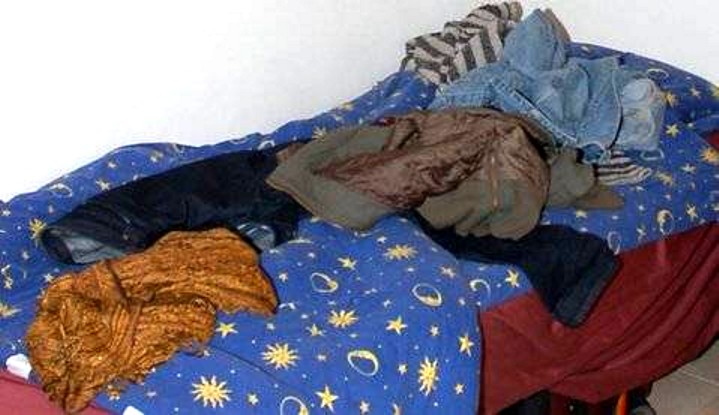
Sollecito did not accompany Knox to the store but this would be because he was known to Quintavalle whereas he was unfamiliar with her. He may however have accompanied Knox to the cottage and/or have acted as look out for her when she was there.
7. Some conclusions
I have included “The locked room” in the title because of a poster’s observation regarding Guede’s bloody left shoeprints exiting Meredith’s room. There is the simple observation that these footprints are going one way only and not towards the small bathroom. But they do not even turn to face Meredith’s door, and again hard to imagine that this could be so if it was Guede who locked her door!
We can rule out Guede as having been involved in any aspect of the clean up precisely because of that trail of footprints and other evidence of his presence left behind.
Now that the travesty of the Hellmann acquittals has been truly exposed Knox and Sollecito face an impossible uphill task.
The clean up and the locked door are just two of many elements in this case which combine together and corroborate each other in a manner that enables us to see the truth beyond a reasonable doubt.
Friday, April 19, 2013
Twenty Forensic Reasons Why Guede Could NOT Have Attacked Meredith Alone
Posted by Cardiol MD
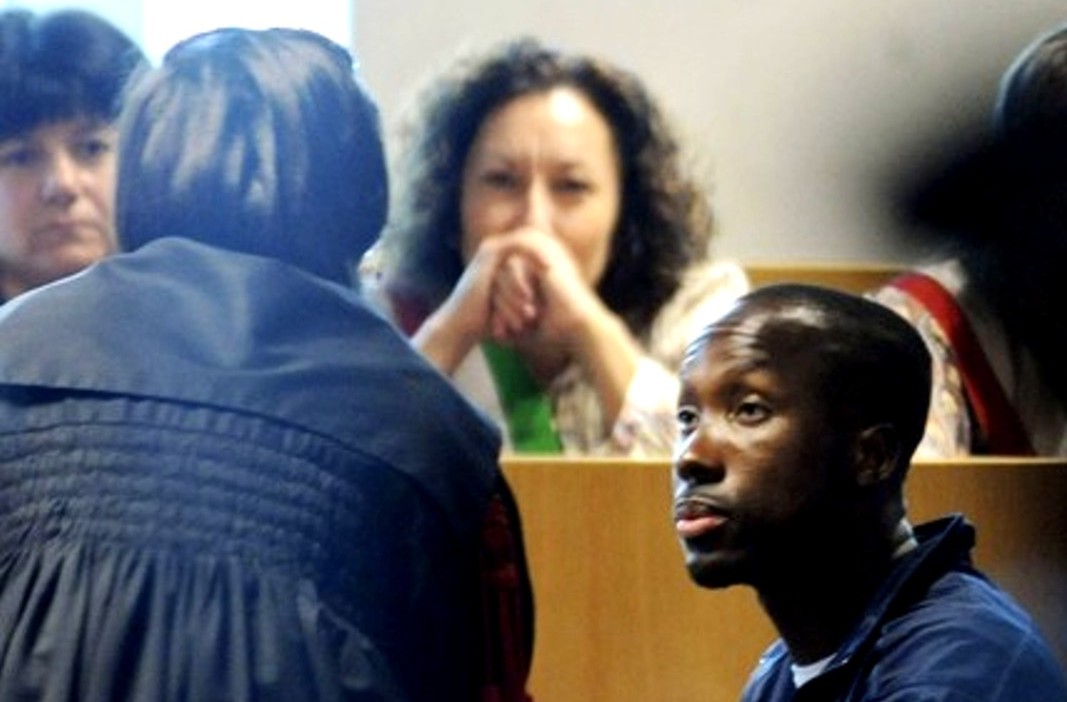
[Bongiorno in 2011 trying to rattle an unshakable Guede claiming Knox and Sollecito did the crime]
1. Guede Persona, An Overview
The convicted murderer Rudy Guede to this day claims that Meredith let him into the house, so we cut him no slack for that.
But at the same time he was no drifter or serial knife carrier, he had no police record in 2007 (unlike Knox and Sollecito), and no drug dealing or breaking-and-entering has ever been either charged or proved.
In October 2008 Judge Micheli mistrusted and sharply rebuked a witness who claimed it just might have been Guede who broke into his house.
Guede seriously discounted his role on the night of Meredith’s death, but some physical evidence (not a lot) proved he had played a part in the attack. Thereafter his shoeprints lead straight to the front door.
2. Moving Target In Court
Neither Judge Micheli nor Judge Massei nor the Supreme Court believed he acted alone or had any part in the very obvious cleanup that had been carried out.
The Knox and Sollecito defenses failed miserably to prove he climbed in Filomena’s window, and despite much innuendo they never really tried to prove he was a lone attacker.
That is why in 2011 we saw two of the most bizarre defence witnesses in recent Italian legal history, the jailbirds Alessi and Aviello, take the stand
Alessi became so nervous making his perjured claim that Guede told him Guede did it with two others that he was physically sick and had to take time off from the stand.
Aviello loudly proclaimed that his brother and another did it (not Guede) and then claimed the Sollecito family via Giulia Bongiorno floated bribes in his prison for false testimony.
Tellingly, although Bongiorno threatened to sue Aviello, she never has. Even more tellingly, Judge Hellmann himself initiated no investigation and simply let this serious felony claim drop dead.
Here is a far-from-exhaustive list of 20 reasons why Rudy Guede could not have acted alone. Also why not one scrap of evidence has ever been found for any two other than Knox and Sollecito themselves.
3. Twenty Lone-Wolf Disproofs
1. Guede’s Final Appeal Report said Meredith sustained 43 wounds
The testimony at the 2009 trial about the 43 wounds was presented in closed court out of humane respect by the jury for the feelings of Meredith’s family.
So even the diligent and trustworthy Italian media mostly missed this, as they were locked outside.
Mention of the 43 wounds was omitted from the 2009 Massei Trial Report and also from the 2011 Hellman Appeal Report.
Its inclusion in the December 2010 in Judge Giordano’s Supreme Court report on Guede’s final appeal reflects the report’s excellent factual completeness.
The PMF translation reads, in relevant part:
The body presented a very large number of bruising and superficial wounds – around 43 counting those caused by her falling – some due to a pointed and cutting weapon, others to strong pressure: on the limbs, the mouth, the nose, the left cheek, and some superficial grazing on the lower neck, a wound on the left hand, several superficial knife wounds or defence wounds on the palm and thumb of the right hand, bruises on the right elbow and forearm, ecchymosis on the lower limbs, on the front and inside of the left thigh, on the middle part of the right leg, and a deep knife wound which completely cut through the upper right thyroid artery fracturing the hyoid bone, a wound which caused a great deal of bleeding.
Including the number of minutes occupied by an initial verbal confrontation, the escalation of that confrontation into taunting and then the physical attack, leading to the infliction of 43 wounds, and to the fatal stabbing, how many minutes would all of this occupied?
The prosecution estimated it took fifteen.
2. Meredith had taken dance classes and played football & karate)
See the Massei Translation, p23.
Every day Meredith called her family, with whom she had a very close relationship. She had taken classes in dance and played sports (football, karate); she was a strong girl, both physically and in terms of temperament (cf. statements by her mother and by her sister Stephanie, hearing of June 6, 2009).
3. Meredith was a strong girl, physically and in temperament
See the statements by her mother and by her sister Stephanie (hearing of June 6, 2009). and description of her karate. (Massei Translation, pp23, 164, 366, and 369).
With regard to the totality of these circumstances, it must be considered that Meredith could only have made an outright refusal to Rudy’s advances and in doing so could also count on her slim [fit] physique, which the photos allow [one] to understand, [and] on her good athletic training (other than dance she had also done sports characterised by a certain physicality such as football, and had even taken a course in karate), sustained by her strong character.
4. Meredith must have been “strongly restrained”
See the Massei Translation, p371; p399, in the Italian original.
Conversely, considering the neck wounds sustained, it must be believed that Meredith remained in the same position, in a standing position, while continuously exposing her neck to the action of the person striking her now on the right and now on the left. Such a situation seems inexplicable if one does not accept the presence of more than one attacker who, holding the girl, strongly restrained her movements and struck her on the right and on the left because of the position of each of the attackers with respect to her, by which it was easier to strike her from that 372 side. One of these attackers was Rudy and the others were those who allowed Rudy to enter the house and who were with him in the house and who, in order to lead the nvestigations astray, then organised the staging of the broken window and the mess in Romanelli’s room: Amanda Knox and Raffaele Sollecito, according to all that has already been shown.
5. Meredith remained virtually motionless throughout the attack
That was in spite of Meredith’s physical and personality characteristics [Massei Translation p369] [Massei Translation p370-371].
A first indication to be taken into account is Meredith’s physical build: the photographs of her body and the data of her approximate height and weight reveal a physique with “normotrophic muscular mass and normally distributed subcutaneous fat” (cf. declarations Lalli p. 3), a slim physique which would have permitted Meredith to move with agility. To this must be added the declarations of the parents and the sister of Meredith. Her mother, Arline Carol Mary Kercher, recalled that Meredith had practised football and karate (p. 7 hearing 6 June 2009), and her sister, Stephanie Arline Lara, stated that Meredith also did boxing, if only the once, and that “physically she was very strong” (p. 20, hearing 6 June 2009). Also her father, John Leslie Kercher, declared that his daughter was quite strong and had taken a course in karate (p. 23 hearing 6 June 2009). It has also been noted that Meredith was not in bed and undressed when the “advances” and the attempts to subject her will commenced. Being still dressed and awake, and since it must be excluded because of what has been said above that the violent action could have taken place with Meredith lying on the bed, it is considered that she, who was sober and fully conscious since no traces indicating either the use of drugs or the abuse of alcohol were found, would have opposed a firm resistance, as she could claim a strong physique, experienced in self-defence by the lessons in karate that she had taken.
6. The defensive wounds were almost non-existent
See the report of Dr Lalli, pp. 33, 34, 35 with the relevant photos. Massei Translation p370.
The signs of this resistance, however, consist in a scream, the scream heard by Nara Capezzali at around around 23:30 and by Maria Ilaria Dramis when, having gone to bed at 22:00 pm, she awoke at a later time which she was not able to quantify; they consist also in some tiny defensive wounds: one on the palm of her [396] right hand of a length of .6cm showing a tiny amount of blood; another on the ulnar surface of the first phalange of the second finger of the left hand, also of length .6cm; another on the fingertip of the first finger with a 370 superficial wound of .3cm, and another tiny wound corresponding to the fourth radius. Compared with these almost nonexistent defensive wounds (cf. report of Dr Lalli, pp. 33, 34, 35 with the relevant photos), there is an injured area which is impressive by the number, distribution and diversity, specifically of the injuries (bruises and wounds) on the face and neck of Meredith.
7. One killer couldn’t inflict 43 wounds with so few defensive wounds.
See the Massei Report quotes above.
8. There must necessarily have been two knives at the scene of the crime
See the Massei Translation p377.
Even this consideration, therefore, leads one to hold that the biological trace attributable to Amanda and found on the knife handle, could have derived from the use of the knife for the purpose of striking, rather than to cut food; it could have derived, therefore, from the harmful action carried out against Meredith and as a consequence, a biological trace attributable to Meredith remained in the tiny striations present on the face of the blade, in spite of the subsequent cleaning, and which does not appear otherwise explainable as to how, in this regard, it was to be found there (Meredith had never been in Raffaele Sollecito’s house and could never have used this knife). Moreover, the knife Raffaele Sollecito carried with him had a definitely shorter blade as has been seen than the length that would have been necessary for causing the deeper resulting wound, with a depth of 8cm, and therefore, there must necessarily have been two knives at the scene of the crime, first one, and then the other, being used against Meredith.
9. A lone killer would need one hand/arm or both to restrain Meredith
So how could he use 2 knives? To use 2 knives a lone killer would have to place 1 knife down, leaving blood-stain[s] wherever it was placed, and then reach for the other knife.
Even wiping the blades on the killer’s clothes, using the one hand, and later scrubbing of the knives would not erase all the blood, as has already been demonstrated.
10. Two killers could divide attack, one holding Meredith, both holding knives
Meanwhile the other killer used one hand/arm to restrain Meredith, and the other hand to use the various knives. Could a lone killer accomplish all that?
11. Meredith’s shoes, pants and underwear had been removed
See the Massei Translation p.370
“It is impossible to imagine in what way a single person could have removed the clothes that Meredith was wearing (shoes, pants and underwear), and using the violence revealed by the vaginal swab, could have caused the resulting bruises and wounds recalled above, as well as removing her sweatshirt, pulling up her shirt, forcing the bra hooks before tearing and cutting the bra.” [Massei Translation p.370]
12. Meredith’s sweatshirt had been pulled up and removed.
See the [Massei Translation p.370
Furthermore, it is impossible to imagine in what way a single person could have removed the clothes that Meredith was wearing (shoes, pants and underwear), and using the violence revealed by the vaginal swab, could have caused the resulting bruises and wounds recalled above, as well as removing her sweatshirt, pulling up her shirt, forcing the bra hooks before tearing and cutting the bra.
13. Meredith’s bra had been forcibly unhooked
See the Massei Translation p.370
14. Meredith’s bra had been torn
See the Massei Translation p.370
15. Meredith’s bra had been cut
See the Massei Translation p.370
16. Violence to Meredith was revealed by the genital swab.
See the Massei Translation p.370
17. In Hellmann appeal RS’s lawyers didnt allege lone killer
They themselves brazenly introduced false testimony to the effect that there were two other killers.
18. Even Hellmann didn’t deny the complicity of AK and RS
Even H/Z seemed to conclude they are probably guilty, but not beyond a reasonable doubt:
“| in order to return a guilty verdict, it is not sufficient that the probability of the prosecution hypothesis to be greater than that of the defence hypothesis, not even when it is considerably greater, but [rather] it is necessary that every explanation other than the prosecution hypothesis not be plausible at all, according to a criterion of reasonability. In all other cases, the acquittal of the defendant is required.” [H/Z p.92]
19. Judge Micheli, in Guede’s trial, found that Guede did not act alone
And that the evidence implicated Amanda Knox and Raffaele Sollecito as accomplices of Rudy Guede in the murder of Meredith Kercher.
20. Massei found that the evidence implicated AK and RS
He concluded they were joint perpetrators with Rudy Guede in the murder of Meredith Kercher.
4. Obvious Conclusions
Is it really reasonable to claim as Sollecito did in his 2012 book that Guede was a lone killer?
Doesn’t all this contradict the lone-killer theory, beyond a reasonable doubt?
Monday, June 27, 2011
Rudy Guede For The First Time Sort Of Accuses Knox And Sollecito Face To Face
Posted by Our Main Posters
1. Potentially A Huge Day
Tension was really fraught. Everybody involved in the appeal and everybody watching in Italy knew this could be THE day.
Guede had recently lost his final Cassation appeal and in a very hard-line ruling Knox & Sollecito had also been associated with the crime.
He was at this appeal hearing as a prosecution witness, because he had written a letter to the prosecution heatedly denying the claims of a former cellmate, Alessi, that he had said Knox and Sollecito did not attack Meredith with him, another two had.
With seeming nothing to lose, Guede could both deny Alessi’s claim and definitively point the finger of blame at the pair, and thus all three would remain locked up for many years.
2. How The Day Actually Went
Despite a turbulent day in court this was not a shapeshifter event. The problem was that Guede was far too nervous to testify.
He is not normally nervous, but it is rumored that the name of Sollecito’s mafioso Uncle Rocco might have been been whispered in his ear.
So his prison letter was read out for him by the prosecution, and it did include this.
This splendid, marvelous girl was killed by Raffaele Sollecito and Amanda Knox.
Then Sollecito lawyer Bongiorno grew increasingly frustrated in attempting a cross-examination, and Guede ended up barely saying a word. The letter alone is rather diminished evidence.
3. Duncan Kennedy for The BBC
See this on the BBC website by Duncan Kennedy.
Amanda Knox and her ex-boyfriend did kill Meredith Kercher, a man who was also convicted of the 21-year-old’s murder has told an appeal court.
After Rudy Guede confirmed he believed the US student killed her British housemate, Knox jumped to her feet saying she was “shocked and anguished”.
The hearing in Perugia is the first time that all three defendants have given evidence on the same day.
Knox, 23, and Raffaele Sollecito, 26, are appealing their convictions.
Child killerMiss Kercher, of Coulsdon, Surrey, was found with her throat cut at her Perugia flat after what prosecutors claimed was a sex game taken to the extreme.
Knox is serving a 26-year sentence for Miss Kercher’s murder while her Italian co-defendant and ex-boyfriend, Sollecito, was sentenced to 25 years.
Guede told the court that claims by a fellow prison inmate that he thought Knox and Sollecito were innocent were not true. He said he never made that claim to the inmate.
On 18 June, convicted child killer Mario Alessi told the appeal Guede had confided that Knox and Sollecito were innocent.
According to Alessi, Guede said he and a friend went to the house Miss Kercher shared with Knox with the intent of having sex with Miss Kercher and that when she refused, the scene turned violent and his unnamed accomplice slit her throat.
Drug-dealer Guede was jailed for 30 years for the sexual assault and murder of Miss Kercher after a separate fast-track trial. His sentence was reduced to 16 years on appeal.
Guede was in the witness stand as a letter he had written in response to Alessi’s claims was read to the court on Monday.
“This splendid, marvellous girl was killed by Raffaele Sollecito and Amanda Knox,” the letter said.
Guede has previously admitted being in the house at the time of the murder, but denies involvement in Miss Kercher’s death.
After cross-examination by the defence, Guede said he had always believed Sollecito and Knox were behind the murder.
“I’ve always said who was there in that house on that cursed night,” he told the court.
Knox stood up after Guede’s evidence and denied his claims.
“The only time that Rudy Guede, Raffaele and I were in the same space has been in court. I’m shocked and anguished.
“He knows we weren’t there and have nothing to do with it,” she said.
Sollecito said Guede was always talking “about a shadow that could be me and a voice that could be Amanda’s… we’ve been fighting shadows for four years. Our lives have been destroyed in a subtle and absurd way.”
Speaking before Monday’s hearing, Knox’s mother Edda Mellas told reporters she hoped that Guede would have the “integrity to stand up and tell the truth”.
She said her daughter was “always very anxious and nervous but I think she’s glad things are moving along. She feels things are going well,” but that it is, “hard to get too hopeful, especially after the first trial.”
Two other witnesses were called to counter claims made by another defence witness, a member of the Mafia named Luciano Aviello, who had told the court earlier this month that his brother - who is on the run - had killed Miss Kercher during a botched burglary.
The two witnesses - two inmates at the same prison as Aviello - testified that Aviello had said he had been contacted by Sollecito’s defence team to stir up confusion in the trial in exchange for money.
Witness Alexander Ilicet said Aviello had wanted the money for a sex-change operation.
4. Andrea Vogt For The Seattle PI
See this in the report in the Seattle PI by Andrea Vogt.
As if the appeal wasn’t bizarre enough, two convicts were called by the prosecution as counter witnesses Monday to contradict several inmates called by the defense earlier this month.
They maintained they had overheard in prison conversations about a plot among other inmates to testify in exchange for money and benefits, such as reduced prison time.
The person they heard was arranging things, they said, was Sollecito’s attorney, Giulia Bongiorno, who heads up Italy’s parliamentary justice committee.
She forcefully denied the corruption accusations in the break afterwards and vowed to file charges and take legal action against her accusers.
One claim by the inmates was that Bongiorno offered a sex change operation to Luciano Aviello. It would be helpful if some of this if it exists emerged on tape. What possible reason would they have to lie?
5. And So To The Bottom Line
Along with Judge Hellman’s increasingly evident bias, and the smoke being blown over the DNA, and the Sollecitos and Bongiorno not (at least not yet) investigated by the judge for alleged witness bribes, not to mention Uncle Rocco’s power to alarm even by whispered mention of his name, the Knox and Sollecito defenses are down, but not yet for the count.
6. And A Footnote On The Kabuki Dance
This for the first time on Guede’s side (but not on Knox’s or Sollecito’s side) crosses a public boundary between the three.
The Italian lawyer Cesare Beccaria explained it thus..
Tuesday, February 22, 2011
Open Questions: An Experienced Trial Lawyer Recommends How To Zero In On the Truth
Posted by SomeAlibi
Welcome
If you’ve come to this website because of the Lifetime movie of Meredith Kercher and Amanda Knox, then welcome.
Like all of us who come to this case, you have one key question: did they do it? The movie you’ve just watched is equivocal on that matter and perhaps didn’t help you at all.
On the internet, you will find people who are passionate in their defence of Amanda Knox and Raffaele Sollecito and you will find people who are passionate in their support of the prosecution.
My own arrival
Placing my own cards on the table here: as a twenty-plus year practising trial lawyer, I am firmly a part of that latter camp. But it wasn’t always that way.
It was information ““ evidence ““ that changed my views. What became very clear to me, early on, was that very few people in the English-speaking world are aware of anywhere near all of the evidence in this case.
I had thought I had grasped the core of the case, but I did not. The case is deep and complex and like many criminal cases, the complete facts behind it have been only sketchily reported in the media. The movie you may have just watched only skirts the real reasons the jury convicted.
The unanimous jury
I am sure that we all agree that no jury, in any murder case, given the awesome responsibility of adjudicating on (young) people’s lives for a multi-decade period of imprisonment, condemns people lightly.
It should be a matter of logic that the evidence presented against the accused must have been deep and satisfied the 6 lay jurors and 2 judges on the case for them to pronounce that huge judgement. That doesn’t mean that there couldn’t be the possibility of a mistrial, but clearly the evidence presented must have been substantial.
In this, we’ve already hit the first problem. Some supporters of Amanda Knox and Raffaele Sollecito will tell you there’s no evidence against them.
This is patently silly. No jury ever convicts people and sends them to prison for 24 plus years without being quite convinced of the case against them. Miscarriages of justice do happen, but the idea that there is “no evidence” can be summarily dismissed.
The only question is whether the evidence is sufficient, true and accurate.
The voluminous evidence
So is the evidence enough to convict beyond a reasonable doubt? The six lay jurors and two professional judges thought so, clearly. What you realise, when you come to the facts of the case, is that the evidence is based not around a single key event but on multiple points.
It can be astonishing to realise that the case is based not only on DNA evidence but also on cellphone evidence and computer records and further yet on multiple conflicting and contradicting versions of what happened that night from the mouths of the accused, not to mention falsely accusing an innocent man of responsibility for murder causing his incarceration.
The wealth of evidence is actually extremely unusual. It goes way beyond the quite similar Scott Peterson case.
The Massei Sentencing Report
What is absolutely new to the English speaking legal world is that the reasoning for the conviction can be read in an extremely detailed 440+ page report online. Bilingual posters at the Perugia Murder File Forum many of whom who are also key posters at TJMK translated the entire document into English over several months last year.
It was my privilege to play an extremely small part in that work. People from four different continents with backgrounds in forensic science, law, academia and a host of other disciplines participated.
You can read an effective executive summary by clicking on the Massei Report link at top here and reading the conclusions from page 388 onwards:
The Knox PR campaign
If you are new to this case, you will likely be shocked how much evidence there is against the convicted parties. Amanda Knox’s family have spent over $1m and involved a professional PR agency called Gogerty Marriot to suggest otherwise in the English-speaking media.
You might wonder why an innocent person needs a million dollar PR campaign on their part. Make yourself a coffee and read the conclusions of the judge’s report. It will take you about 15 minutes. Up until you read this report, almost everything you watch, hear and read is PR spin and is quite deliberately positioned to make you believe there is no case.
When you complete it, I believe you will have a very different take. That 15 minutes could change your ideas about everything you thought you knew about the murder of Meredith Kercher.
Now for a quick tour of the evidence.
Some of the points of evidence
Consider as you read it what is your own possible explanation for each of the following:
- the fact that the wound pattern and the reconstruction of the attack, each presented at trial in extensive closed-court sessions, showed this absolutely had to be a pack attack;
- the DNA of Raffaele Sollecito on Meredith’s bra-clasp in her locked bedroom;
- the almost-entire naked footprint of Raffaele on a bathmat that in *no way* fits that of the other male in this case - Rudy Guede;
- the fact that Raffaele’s own father blew their alibi that they were together in Raffaele’s flat at the time of the killing with indisputable telephone records;
- the DNA of Meredith Kercher on the knife in Raffaele’s flat which Raffaele himself sought to explain as having been from accidentally “pricking” Meredith’s hand in his written diary despite the fact Meredith had never been to his flat (confirmed by Amanda Knox);
- the correlation of where Meredith’s phones were found to the location of Raffaele Sollecito and Rudy Guedes’s flats;
- the computer records which show that no-one was at Raffaele’s computer during the time of the murder despite him claiming he was using that computer;
- Amanda’s DNA mixed with Meredith Kercher’s in five different places just feet from Meredith’s body;
- the utterly inexplicable computer records the morning after the murder starting at 5.32 am and including multiple file creations and interactions thereafter all during a time that Raffaele and Amanda insist they were asleep until 10.30am;
- the separate witnesses who testified on oath that Amanda and Raffaele were at the square 40 metres from the girls’ cottage on the evening of the murder and the fact that Amanda was seen at a convenience store at 7.45am the next morning, again while she said she was in bed;
- the accusation of a completely innocent man by Amanda Knox again and again when under no pressure which she insisted on putting in writing;
- the fact of Knox’s claim that she was aggressively interrogated for days, although she did not even have the status of a witness, and signed every page of every typed record of her mild, mundane and quite limited questionings;
- the fact that during Knox’s very unconvincing performance on the witness stand in July 2009 she admitted she was treated well and was not abused;
- the fact that when Amanda Knox rang Meredith’s mobile telephones, ostensibly to check on the “missing” Meredith, she did so for just three seconds - registering the call but making no effort to allow the phone to be answered in the real world
- the knife-fetish of Raffaele Sollecito, and his formal disciplinary punishment for watching animal porn at his university so far from the wholesome image portrayed;
- the fact that claimed multi-year kick-boxer Raffaele apparently couldn’t break down a flimsy door to Meredith’s room when he and Amanda were at the flat the morning after the murder but the first people in the flat with the police who weren’t martial artists could;
- the extensive hard drug use of Sollecito as told on by Amanda Knox;
- the fact that Amanda knew details of the body and the wounds despite not being in line of sight of the body when it was discovered;
- the lies of Knox on the witness stand in July 2009 about how their drug intake that night (“one joint”) is totally contradicted by Sollecito’s own contemporaneous diary;
- the fact that after a late evening’s questioning, Knox wrote a 2,900 word email home which painstakingly details what she said happened that evening and the morning after that looks *highly* like someone committing to memory, at 3.30 in the morning, an extensive alibi;
- the fact that both Amanda and Raffaele both said they would give up smoking dope for life in their prison diaries despite having apparently nothing to regret;
- the fact that when Rudy Guede was arrested, Raffaele Sollecito didn’t celebrate the “true” perpetrator being arrested (which surely would have seen him released) but worried in his diary that a man whom he said he didn’t know would “make up strange things” about him despite him just being one person in a city of over 160,000 people;
- the fact that both an occupant of the cottage and the police instantly recognised the cottage had not been burgled but had been the subject of a staged break-in where glass was *on top* of apparently disturbed clothes;
- the fact that Knox and Sollecito have feuded quite publicly ever since November 2007 and have shown far more anger toward one another than either has ever shown toward Guede;
- the fact that Knox and Sollecito both suggested each other might have committed the crime and Sollecito TO THIS DATE does not agree Knox stayed in his flat all the night in question;
- the fact of the bizarre behaviour of both of them for days after the crime;
- the fact that cellphone records show Knox did not stay in Sollecito’s flat but had left the flat at a time which is completely coincidental with Guede’s corroborated presence near the girl’s flat earlier in the evening;
- the fact that Amanda Knox’s table lamp was found in the locked room of Meredith Kercher in a position that suggested it had been used to examine for fine details of the murder scene in a clean up;
- the unbelievable series of changing stories made up by the defendants after their versions became challenged;
- Knox’s inexplicable reaction to being shown the knife drawer at the girl’s cottage where she ended up physically shaking and hitting her head despite being joyful earlier at the police station.
In conclusion
This list is not exhaustive. It goes”¦ on”¦ and on”¦ and on”¦ And yet, those supporting Knox will tell you that’s all made up, all coincidental.
Really? Does the weight of all that evidence sound made up to you?
If so, it must be the most over-rigged criminal case in the history of crime. Unlikely beyond all and any reasonable doubt.
The judge’s report explains why the jury found the defendants guilty. I truly expect you will be astonished at the amount of evidence if all you’ve done is watched a film or read a few press reports.
For any questions thereafter, please join us and post them on truejustice.org or perugiamuderfile.org . You’ll find here a host of good people who are all working on a totally volunteer basis in memory of the only victim of this crime.
Meredith Susanna Cara Kercher. RIP.
Thursday, October 08, 2009
Newsweek’s Barbie Nadeau Has A Really Vital Piece On How The Evidence Stacks Up
Posted by Peter Quennell
And, in short, it is ominous.
Click above for the full report. This really IS vital reading. A few key excerpts as follows.
Evidence: Rudy Guede
Who it hurts: Knox and Sollecito
Rudy Guede is the 24-year-old Ivory Coast native convicted in a fast-track trial last October for his role in Kercher’s murder. He is serving a 30-year sentence (his appeal begins on Nov. 19). Guede, who refused to testify in the Knox trial, has admitted that he was in the house when Kercher was killed. He says Kercher invited him there and that the two were making out when a stomach cramp from a bad kebab sent him to the bathroom. He was on the toilet with his iPod headphones on through four songs and, when he came out, Kercher was dying. He says he tried to save Kercher by using a towel to sop up the blood on her neck wounds, but he was scared after a man he says looked like Sollecito told him that “they’ll pin this on the black guy.” Guede fled to Germany, where he was later arrested for skipping a train fare. His feces (found in a toilet), along with his DNA and fingerprints from Kercher’s bedroom, link him to the crime scene. The sentencing judge who convicted him, though, did not see him as a lone assailant. Instead, the judge wrote in his sentencing report that he believed Guede acted with Knox and Sollecito.
Evidence: Murder dynamic
Who it hurts: Knox and Sollecito
One of the most complicated aspects of Kercher’s tragic death is how the murder itself played out. The prosecution believes that Knox, Sollecito, and Guede taunted Kercher in a sex game that quickly escalated to violence and ended in murder. Countless forensic experts, including those who performed the autopsies on Kercher’s body, have testified that more than one person killed her based on the size and location of her injuries and the fact that she didn’t fight back””no hair or skin was found under her fingernails. The defense has confused matters more: Knox’s forensic specialist testified that Kercher had been killed by only one person from the front, but Sollecito’s expert testified that Kercher had been killed by one person from behind.
Evidence: Knox’s confession
Who it hurts: Knox
On Nov. 5, 2007, Sollecito was called to the Perugia police station for questioning about Kercher’s murder. Knox testified last June that she did not want to be alone, so she accompanied him. During his interrogation, Sollecito admitted to police that he did not know for sure if Knox actually spent the night of the murder at his house, as she had told police earlier. Since Knox was at the police station, the head of the murder squad decided to ask her a few questions. Her interrogation started at about 11 p.m., and, by 5:45 a.m., Knox had told police that she was in the house when Kercher died””and that Patrick Lumumba, the owner of the nightclub where she worked, was the assailant. She even described Kercher’s screams. She, Sollecito, and Lumumba were arrested. The next day, Knox wrote a five-page memorandum reiterating everything she said the night before. But since there was no lawyer present during her interrogation””and so far no one has produced an audiotape of the interrogation””Knox’s attorneys were able to have her verbal confession thrown out of evidence. The five-page memorandum still holds….
Evidence: Conflicting alibis
Who it hurts: Unknown
Knox maintains that she spent the night of Nov. 1, 2007, at Sollecito’s house. Sollecito did not take the stand during this trial, and his lawyer told NEWSWEEK that it was, at least in part, because he could not corroborate Knox’s alibi….
So Sollecito did not take the stand in part because he could not corroborate Knox’s alibi. Wow. That has to hurt.
Very much more in Barbie Nadeau’s original piece. We recommend that you read it all.
Saturday, September 19, 2009
Trial: Defense Returns To Weapon While Most Of Prosecution Case Still Not Contended
Posted by Peter Quennell

Journalists were asked to leave the courtroom today during a weak repeat of the contention that the large knife was not THE weapon.
But the prosecution had already indicated months ago that they believed at least one other knife was involved.
Click above for Nick Squires on one report from the press room outside the court.
The black-handled knife, with a 6.5 inch long stainless steel blade, was shown for the first time to the court in Perugia where the 22-year-old American student and her Italian ex-boyfriend, Raffaele Sollecito, 26, are accused of sexual assault and murder.
A court official brought out the knife in a shallow white cardboard box marked “Evidence ““ handle with care” and showed it to the judge and eight jurors.
Miss Knox, of Seattle, who was wearing blue jeans and a red sweatshirt with a Beatles design, appeared impassive as the purported murder weapon was shown during the testimony of a forensic expert, Prof Giancarlo Umani-Ronchi.
She looked away when police photographs of Miss Kercher’s bloodied body were projected onto a giant screen in the courtroom.
Mr Sollecito, in a white jacket and rimless glasses, bit his fingernails as the alleged use of the knife in the killing was discussed by experts and lawyers.
A forensic consultant, Mariano Cingolani, said that of the three wounds on Miss Kercher’s neck, at least one was not compatible with the size and dimensions of the knife.
“Many other knives in general are more compatible with that kind of wound,” said Prof Cingolani. The wound was too narrow to match the knife, he said.
He added, however, that no firm conclusion could be drawn without knowing the exact angle of Miss Kercher’s neck, or the elasticity of her muscle tissue…
The former lovers, who could be sentenced to life in prison if found guilty, looked tired and nervous.
So there is a question mark over the role of the large knife but again, nothing definitive. No defense attempt to prove that no other knife was used.
Meanwhile, whole other universes of very damning prosecution evidence against Sollecito and Knox remain uncontested, like a herd of elephants in the room.
For example the very damning mobile calls. And also the highly confused alibis.
Wednesday, August 19, 2009
Case For The Prosecution #4: Amanda Knox’s Multiple Conflicting Alibis
Posted by The Machine
The Knox Alibis: How They Conflict
The first three posts on the power of the case were on the DNA evidence, the luminol-enhanced footprint evidence, and Raffaele Sollecito’s various conflicting alibis.
Now we look at the various conflicting alibis that Amanda Knox has given for the night in question. We dont yet have full transcripts and have to rely on what was reported in the UK press.
Please click here for more
Thursday, July 30, 2009
Case For The Prosecution: #3 Raffele Sollecito’s Multiple Conflicting Alibis
Posted by The Machine

[above: Sollecito with his lawyer Giulia Bongiorno; click for a larger image]
The Sollecito Alibis: How They Conflict
The first two posts on the power of the case were on the DNA evidence, and the luminol-enhanced footprint evidence.
In this and the next post we will elaborate upon the testimony relevant to the multiple alibis given by Amanda Knox and Raffaele Sollecito and the evolving circumstances in which they were given.
Following the discovery of Meredith’s body in her house, more than a dozen possible witnesses were quite expeditiously questioned: Meredith’s various English friends, her two Italian housemates, the four boys who lived downstairs, and Knox and Sollecito.
Meredith’s English friends, her two Italian housemates, and the boys downstairs fully cooperated with the police. They seemed to be telling the truth. They had one alibi each that could readily be verified. Those alibis never changed.
As a direct result they were all quickly eliminated from the investigation.
In stark contrast, Amanda Knox and Raffaele Sollecito appeared to be obfuscating. They appeared callous, impatient, arrogant, and reluctant to cooperate with the police.
These were attitudes first publicly noted as incriminating in mid 2008 by the judges at the Italian Supreme Court. Police and prosecution did not leak.
Knox and Sollecito each made three separate attempts to come up with credible alibis. All appeared desperate and semi-rehearsed. None of them made total sense or managed to get them off the hook. Neither helped the other at all.
Today, we address Sollecito’s alibis.
The prosecution undermined them in various ways. Sollecito did not take the stand at trial to repeat any of them. His occasional interventions in the courtroom did not strengthen any of them. He made no attempt to corroborate the third alibi of Knox (that she was at his place all night) and immediately prior to arrest he said she had made him lie.
Everyone at and around trial knew of the wariness and extreme anger of the two (and their families) and how they knocked chips off one another whenever they could.
Innocent behavior? You decide. If each was not blaming the other for their plight this behavior would be unique in the history of crime.
Raffaele Sollecito’s first alibi
For his first alibi Raffaele Sollecito claimed, in an interview with Kate Mansey from the Sunday Mirror, that he and Amanda Knox were at a friend’s party on the night of the murder. It appears that this is the alibi that Sollecito also first told the police.
As there seems to have been no party, or in any case no party they attended, it would have been difficult for Sollecito to find any witnesses, and so this alibi was quickly superceded.
Raffaele Sollecito’s second alibi
For his second alibi Sollecito now claimed that he was at his apartment throughout the night with Amanda Knox.
This alibi was contradicted by the forensic evidence presented by the prosecution. According to the testimony of the scientific police from Rome, there were six separate pieces of forensic evidence that placed him in the cottage on Via Della Pergola on the night of the murder.
These included an abundant amount of his DNA on Meredith’s bra clasp, and a bloody footprint on the blue bathmat in Meredith’s bathroom which appears to match the precise characteristics of his foot.
Sollecito’s claim that he was at his apartment the whole evening on 1 November was also undermined by Amanda Knox, who claimed in one of her own witness statements that he was also at the cottage when Meredith was killed:
Yes we were in the house. That evening we wanted to have a bit of fun. We were drunk. We asked her to join us. Diya wanted her. Raffaele and I went into another room and then I heard screams.
This alibi was also undermined by an eyewitness, Antonio Curatolo, the watcher in the park above the house, who testified that he saw Sollecito there. And it was undermined by Sollecito himself when he moved to the third alibi below.
In my previous statement I told a load of rubbish because Amanda had convinced me of her version of the facts and I didn’t think about the inconsistencies.
Although Rudy Guede exercised his right to silence when he was called as a witness in the present trial, it should be noted that at his own trial last October and in the stated grounds for his appeal, he has claimed that Amanda Knox and Raffaele Sollecito were both at the cottage on the night in question, and that they were responsible for Meredith’s murder.
Raffaele Sollecito’s third alibi
Sollecito was asked to return to the police station on 5 November to answer some more questions. He was at that time confronted with telephone records that proved that he and Amanda Knox had lied previously.
So for his third alibi, which now cut Amanda Knox loose and implicated her, Sollecito claimed that he was at his apartment all evening, and that for part of the evening Knox was out, from 9 pm to 1 am.
In my previous statement I told a load of rubbish because Amanda had convinced me of her version of the facts and I didn’t think about the inconsistencies….
Amanda and I went into town at around 6pm, but I don’t remember what we did. We stayed there until around 8.30 or 9pm.
At 9pm I went home alone and Amanda said that she was going to Le Chic because she wanted to meet some friends. We said goodbye. I went home, I rolled myself a spliff and made some dinner.”
He goes on to say that Amanda returned to his house at around 1am and the couple went to bed, although he couldn’t remember if they had sex.
This third alibi was undercut by Amanda Knox when she took the stand and testified. She stated that she was with Sollecito at his place all night.
It was also contradicted by the forensic evidence presented by the prosecution: the six separate pieces of forensic evidence that placed him in the cottage on Via Della Pergola on the night of the murder.
This third alibi was also undermined by the telephone records and by the data taken from his computer.
Sollecito claimed that he had spoken to his father at 11 pm. The phone records showed that to the contrary, there was no telephone conversation at this time, though Sollecito’s father had called him a couple of hours earlier, at 8.40 pm.
Sollecito claimed that he was surfing the internet from 11 pm to 1 am. Marco Trotta, a police computer expert, testified that the last human interaction on Sollecito’s computer that evening was at 9.10 pm and the next human activity on Sollecito’s computer was at 5.32 am.
Sollecito said that he downloaded and watched the film Amelie during the night. However, Mr Trotta said that the film had been watched at around 6.30 pm, and it was earlier testified that Meredith returned to the cottage she shared with Amanda Knox at about 9 pm.
Sollecito claimed that he had slept in until 10 am the next day. There was expert prosecution testimony that his mobile phone was actually turned on at 6.02 am. The Italian Supreme Court remarked that his night must have been “sleepless” to say the least.
This alibi was undermined by the eyewitness Antonio Curatolo, the watcher in the park above the house, who testified that he saw Sollecito there.
Sollecito’s difficult situation resulting
Sollecito does not seem to have done himself any favours by exercising his right to remain silent and not to testify at the trial.
As things now stand, he does not have any credible alibi or scenario for the night of the murder. Also it would appear that he has damaged his overall credibility irreparably, by giving three alibis that differed so considerably.
Judge Paolo Micheli had in front of him much of the same evidence. He wrote, in committing Raffaele Sollecito to trial last October, that he considered the triple alibis to be a clear indication of guilt.
There seems to be no obvious reason right now why the present judges and jury would conclude differently.

